CPanel Extended For WHMCS
(→Common Problems) |
|||
| Line 3: | Line 3: | ||
=About [http://www.modulesgarden.com/products/whmcs/cpanel_extended/features cPanel Extended For WHMCS] = | =About [http://www.modulesgarden.com/products/whmcs/cpanel_extended/features cPanel Extended For WHMCS] = | ||
| + | <h4 style="color: #ff0000; font-weight:bold; text-align:center;">Article update is ongoing on this page, watch out for broken links and unclear descriptions!<br /> | ||
| + | We are sorry for the inconvenience caused.</h4> | ||
{| | {| | ||
|style="padding: 10px 0px 10px 0px;"|'''cPanel Extended For WHMCS''' is a fully featured addon module created in order to facilitate management of cPanel.<br /> | |style="padding: 10px 0px 10px 0px;"|'''cPanel Extended For WHMCS''' is a fully featured addon module created in order to facilitate management of cPanel.<br /> | ||
| − | It allows your customers to manage their web hosting accounts without even accessing cPanel! | + | It allows your customers to manage their web hosting accounts without even accessing cPanel! Its total functionality is relocated directly to the client area.<br /> |
| − | + | It will definitely prove to be a convenient and time saving solution! | |
|} | |} | ||
<!--a comment maybe? --> | <!--a comment maybe? --> | ||
| Line 127: | Line 129: | ||
{| | {| | ||
|style="padding: 0px 0px 15px 15px;"|'''4. In order to configure your license key you have to edit a previously renamed '' 'license.php' '' file.'''<br /> | |style="padding: 0px 0px 15px 15px;"|'''4. In order to configure your license key you have to edit a previously renamed '' 'license.php' '' file.'''<br /> | ||
| − | Enter your license key between quotation marks as presented on the following screen. You can find your license key | + | Enter your license key between quotation marks as presented on the following screen. You can find your license key in your client area → '' 'My Products' ''. |
|} | |} | ||
{| | {| | ||
| Line 136: | Line 138: | ||
{| | {| | ||
|style="padding: 0px 0px 15px 15px;"|'''5. Now you have to activate the module in your WHMCS system.'''<br /> | |style="padding: 0px 0px 15px 15px;"|'''5. Now you have to activate the module in your WHMCS system.'''<br /> | ||
| − | + | Log in to your WHMCS admin area. Click '' 'Setup' '' then choose '' 'Addon Modules' '' . | |
|} | |} | ||
{| | {| | ||
| − | |style="padding: 0px 0px 20px 15px;"|Afterwards find '' 'cPanel Extended Functions' '' and press Activate button. | + | |style="padding: 0px 0px 20px 15px;"|Afterwards, find '' 'cPanel Extended Functions' '' and press '' 'Activate' '' button. |
|} | |} | ||
{| | {| | ||
| Line 145: | Line 147: | ||
|} | |} | ||
{| | {| | ||
| − | |style="padding: 0px 0px 15px 15px;"|'''6. In next step you need to permit access to this module.'''<br /> | + | |style="padding: 0px 0px 15px 15px;"|'''6. In the next step you need to permit access to this module.'''<br /> |
| − | To do so, click on '' 'Configure' '' button, tick | + | To do so, click on '' 'Configure' '' button, tick desired admin roles and press '' 'Save Changes' ''. |
|} | |} | ||
{| | {| | ||
| Line 153: | Line 155: | ||
{| | {| | ||
|style="padding: 0px 0px 15px 15px;"|'''7. Well done! You have just successfully installed cPanel Extended For WHMCS!'''<br /> | |style="padding: 0px 0px 15px 15px;"|'''7. Well done! You have just successfully installed cPanel Extended For WHMCS!'''<br /> | ||
| − | + | You can access the addon under '' 'Addons' '' → '' 'cPanel Extended Functions' ''.<br /> | |
| − | + | Let's proceed to the configuration of your freshly installed module. | |
|} | |} | ||
{| | {| | ||
| Line 161: | Line 163: | ||
==Configuration of Server== | ==Configuration of Server== | ||
{| | {| | ||
| − | |style="padding: 0px 0px 15px 15px;"|'''8. Now we will show you how to configure a new product.'''<br /> | + | |style="padding: 0px 0px 15px 15px;"|'''8. Now, we will show you how to configure a new product.'''<br /> |
| − | + | Go to '' 'Setup' '' → '' 'Products/Services' '' → '' 'Servers' ''.<br /> | |
Afterwards press '' 'Add New Server' ''. | Afterwards press '' 'Add New Server' ''. | ||
|} | |} | ||
| Line 169: | Line 171: | ||
|} | |} | ||
{| | {| | ||
| − | |style="padding: 0px 0px 15px 15px;"|'''9. Next, enter your server name, IP address, username and password. Choose '' ' | + | |style="padding: 0px 0px 15px 15px;"|'''9. Next, enter your server name, IP address, username and password. Choose '' 'cpanelExtended' '' from a dropdown menu and press '' 'Save Changes' ''.'''<br /> |
| − | Keep in mind that | + | If you connect with your cPanel server via SSL then make sure that you checked '' 'Secure' '' located at the bottom of the page.<br /> |
| − | + | ''Note: Keep in mind that the URLs of client area buttons '' 'Login to Webmail' '' and '' 'Login to cPanel' '' are taken from '' 'Hostname' '' or '' 'IP Address' '' field.'' | |
| − | + | ||
|} | |} | ||
{| | {| | ||
| Line 178: | Line 179: | ||
|} | |} | ||
{| | {| | ||
| − | |style="padding: 0px 0px 15px 15px;"|'''10. After | + | |style="padding: 0px 0px 15px 15px;"|'''10. After configuring your server correctly, you will see a following screen.'''<br /> |
Now you need to create a new group for your server. For that purpose press '' 'Create New Group' ''. | Now you need to create a new group for your server. For that purpose press '' 'Create New Group' ''. | ||
|} | |} | ||
| Line 185: | Line 186: | ||
|} | |} | ||
{| | {| | ||
| − | |style="padding: 0px 0px 20px 15px;"|'''11. Enter name, click on your previously created server, press '' 'Add' '' then | + | |style="padding: 0px 0px 20px 15px;"|'''11. Enter name, click on your previously created server, press '' 'Add' '' then '' 'Save Changes' ''.''' |
|} | |} | ||
{| | {| | ||
| − | |style="padding: 0px 0px | + | |style="padding: 0px 0px 30px 25px;"|[[File:CP11.png]] |
|} | |} | ||
==Configuration of Product== | ==Configuration of Product== | ||
{| | {| | ||
| − | |style="padding: 0px 0px 15px 15px;"|'''12. In order to create | + | |style="padding: 0px 0px 15px 15px;"|'''12. In order to create a product, go to '' 'Setup' '' → '' 'Products/Services' '' → '' 'Products/Services' ''.'''<br /> |
If you don't have a product group, click on '' 'Create a New Group' ''. If you do, simply go to step 14. | If you don't have a product group, click on '' 'Create a New Group' ''. If you do, simply go to step 14. | ||
|} | |} | ||
| Line 199: | Line 200: | ||
|} | |} | ||
{| | {| | ||
| − | |style="padding: 0px 0px 20px 15px;"|'''13. | + | |style="padding: 0px 0px 20px 15px;"|'''13. Fill in a product group name and press '' 'Create Group' ''.''' |
|} | |} | ||
{| | {| | ||
| Line 205: | Line 206: | ||
|} | |} | ||
{| | {| | ||
| − | |style="padding: 0px 0px 15px 15px;"|'''14. When you have a product group, you can create your product and assign it with cPanel Extended | + | |style="padding: 0px 0px 15px 15px;"|'''14. When you have a product group, you can create your product and assign it with cPanel Extended module. |
| − | + | ||
|} | |} | ||
{| | {| | ||
| Line 218: | Line 218: | ||
|} | |} | ||
{| | {| | ||
| − | |style="padding: 0px 0px 15px 15px;"|'''16. Now go to '' 'Module Settings' '' section, choose both '' 'CpanelExtended' '' and | + | |style="padding: 0px 0px 15px 15px;"|'''16. Now, go to '' 'Module Settings' '' section, choose both '' 'CpanelExtended' '' and a previously created server group from dropdown menus and press'' 'Save Changes' ''.'''<br /> |
You can also configure your WHM Package here. | You can also configure your WHM Package here. | ||
|} | |} | ||
| Line 227: | Line 227: | ||
==Configuration of Addon== | ==Configuration of Addon== | ||
{| | {| | ||
| − | |style="padding: 0px 0px 20px 15px;"|'''17 | + | |style="padding: 0px 0px 20px 15px;"|'''17. You have just correctly created and customized a new product.'''<br /> |
| − | + | Now, you can define features available in the client area per cPanel Extended product.<br /> | |
| − | Afterwards click on '' 'Features' '' button. | + | Go to '' 'Addons' '' → '' 'cPanel Extended Functions' '' in your WHMCS.<br /> |
| + | Afterwards click on '' 'Features' '' button next to a previously configured product. | ||
|} | |} | ||
{| | {| | ||
| Line 235: | Line 236: | ||
|} | |} | ||
{| | {| | ||
| − | |style="padding: 0px 0px 20px 15px;"|'''18. | + | |style="padding: 0px 0px 20px 15px;"|'''18. Now, tick the features you would like to activate for your customers and press '' 'Save Changes' '' button.''' |
|} | |} | ||
{| | {| | ||
| Line 241: | Line 242: | ||
|} | |} | ||
{| | {| | ||
| − | |style="padding: 0px 0px 20px 15px;"|'''19. Now, press | + | |style="padding: 0px 0px 20px 15px;"|'''19. Now, press '' 'Install Apps' '' button.''' |
|} | |} | ||
{| | {| | ||
| Line 248: | Line 249: | ||
{| | {| | ||
|style="padding: 0px 0px 15px 15px;"|'''20. Tick '' 'Install App' '', choose your Auto Installer from a dropdown menu. Afterwards tick '' 'Install Button' '' and '' 'Backup Button' ''.'''<br /> | |style="padding: 0px 0px 15px 15px;"|'''20. Tick '' 'Install App' '', choose your Auto Installer from a dropdown menu. Afterwards tick '' 'Install Button' '' and '' 'Backup Button' ''.'''<br /> | ||
| − | You can also choose desired language of the | + | You can also choose desired language of the applications by entering value into the '' 'Language' '' field. [http://softaculous.com/docs/Scripts_Language_Codes Complete list of language codes can be found here.]<br /> |
| − | If the field is left blank, | + | If the field is left blank, a default value, which is '' 'en' '' (english) will be used.<br /> |
| − | ''Note: You can also | + | ''Note: You can also create a configurable option with app to install, you can find the instruction to do that [http://www.docs.modulesgarden.com/CPanel_Extended_For_WHMCS#Assignment_of_Custom_Fields_To_Application_Autoinstall here].'' |
|} | |} | ||
{| | {| | ||
| Line 256: | Line 257: | ||
|} | |} | ||
{| | {| | ||
| − | |style="padding: 0px 0px 15px 15px;"|'''21. From now on all your clients who ordered previously created | + | |style="padding: 0px 0px 15px 15px;"|'''21. From now on, all your clients who ordered a previously created product will be able to manage their cPanel accounts via your WHMCS system.'''<br /> |
This is what your customers should see in their client area: | This is what your customers should see in their client area: | ||
|} | |} | ||
| Line 265: | Line 266: | ||
=Management= | =Management= | ||
{| | {| | ||
| − | |style="padding: 10px 0px 15px 15px;"|'''cPanel Extended allows your customers to manage their cPanel account via client area | + | |style="padding: 10px 0px 15px 15px;"|'''cPanel Extended allows your customers to manage their cPanel account via the client area of your WHMCS system.'''<br /> |
| − | In this short guide we will present you the possibilities of our | + | In this short guide we will present you the possibilities of our module. |
|} | |} | ||
| − | == | + | ==Client Area== |
{| | {| | ||
| − | |style="padding: 10px 0px 20px 15px;"|You can manage your FTP accounts through creating, modifying and deleting. | + | |style="padding: 10px 0px 20px 15px;"|This section shows features available in the client area. |
| + | |} | ||
| + | ===FTP Accounts=== | ||
| + | {| | ||
| + | |style="padding: 10px 0px 20px 15px;"|You can manage your FTP accounts through creating, modifying and deleting them. | ||
|} | |} | ||
{| | {| | ||
|style="padding: 0px 0px 30px 25px;"|[[File:CP22.png]] | |style="padding: 0px 0px 30px 25px;"|[[File:CP22.png]] | ||
| + | |} | ||
| + | ===Files=== | ||
| + | {| | ||
| + | |style="padding: 10px 0px 20px 15px;"|Files page, as its name suggests, allows you to view and manage files and folders of your cPanel account. | ||
| + | |} | ||
| + | {| | ||
| + | |style="padding: 0px 0px 30px 25px;"|[[File:CP22_1.png]] | ||
| + | |} | ||
| + | |||
| + | ===SSH Management=== | ||
| + | {| | ||
| + | |style="padding: 10px 0px 20px 15px;"|Here, you can configure your SSH keys pair.<br /> | ||
| + | Afterwards, you can connect to your cPanel, for example via PuTTY, with your private SSH key. | ||
| + | |} | ||
| + | {| | ||
| + | |style="padding: 0px 0px 30px 25px;"|[[File:CP22_2.png]] | ||
| + | |} | ||
| + | |||
| + | ===MX Management=== | ||
| + | {| | ||
| + | |style="padding: 10px 0px 20px 15px;"|This page enables you to manage your MX records for each of your domains. | ||
| + | |} | ||
| + | {| | ||
| + | |style="padding: 0px 0px 30px 25px;"|[[File:CP22_3.png]] | ||
|} | |} | ||
| − | == | + | ===Emails=== |
{| | {| | ||
| − | |style="padding: 10px 0px 20px 15px;"| | + | |style="padding: 10px 0px 20px 15px;"|In this page you can manage all aspects related to email accounts. |
|} | |} | ||
{| | {| | ||
|style="padding: 0px 0px 30px 25px;"|[[File:CP23.png]] | |style="padding: 0px 0px 30px 25px;"|[[File:CP23.png]] | ||
|} | |} | ||
| − | == | + | ===Email Forwarders=== |
{| | {| | ||
| − | |style="padding: 10px 0px 20px 15px;"|Here you can | + | |style="padding: 10px 0px 20px 15px;"|Here you can set up email forwarders and email domain forwarders. |
|} | |} | ||
{| | {| | ||
| Line 291: | Line 320: | ||
|} | |} | ||
| − | == | + | ===Databases=== |
{| | {| | ||
| − | |style="padding: 10px 0px 20px 15px;"|Owing to MySQL Databases Management you can create/delete | + | |style="padding: 10px 0px 20px 15px;"|Owing to MySQL Databases Management you can create/delete databases and users.<br /> |
| + | You can also assign users to particular databases and set up their privileges. | ||
|} | |} | ||
{| | {| | ||
| Line 299: | Line 329: | ||
|} | |} | ||
| − | == | + | ===Cron=== |
{| | {| | ||
|style="padding: 10px 0px 20px 15px;"|Management of cron allows you to add and monitor your cron jobs. | |style="padding: 10px 0px 20px 15px;"|Management of cron allows you to add and monitor your cron jobs. | ||
| Line 307: | Line 337: | ||
|} | |} | ||
| − | == | + | ===Subdomains=== |
{| | {| | ||
| − | |style="padding: 10px 0px 20px 15px;"|You can create and manage | + | |style="padding: 10px 0px 20px 15px;"|You can create and manage subdomains of your domain. |
|} | |} | ||
{| | {| | ||
|style="padding: 0px 0px 30px 25px;"|[[File:CP27.png]] | |style="padding: 0px 0px 30px 25px;"|[[File:CP27.png]] | ||
|} | |} | ||
| − | == | + | ===Addon Domains=== |
{| | {| | ||
| − | |style="padding: 10px 0px | + | |style="padding: 10px 0px 15px 15px;"|Addon domains management is available on this page.<br /> |
| + | Addon domains allow you to link the domain to a subdirectory of your account. | ||
|} | |} | ||
{| | {| | ||
| Line 322: | Line 353: | ||
|} | |} | ||
| − | == | + | ===Parked Domains=== |
{| | {| | ||
| − | |style="padding: 10px 0px | + | |style="padding: 10px 0px 15px 15px;"|You can add and manage your parked domains.<br /> |
| + | Parked domains allow you to point to another domain of your account. | ||
|} | |} | ||
{| | {| | ||
| Line 330: | Line 362: | ||
|} | |} | ||
| − | == | + | ===Domain Forwarders=== |
{| | {| | ||
| − | |style="padding: 10px 0px | + | |style="padding: 10px 0px 15px 15px;"|Easy access to domain forwarders is very useful. Within a few seconds, you can redirect the page to point to another.<br /> |
| + | Redirect option allows you to make a specific web page redirect to another page and display the contents of that page.<br /> | ||
| + | For example, if your main domain is '''mytestingdomain.com''', you can make such forward:<br /> | ||
| + | '''mytestingdomain.com/redirect''' → ''''adomainwithlongname-averylongname.com''' | ||
|} | |} | ||
{| | {| | ||
| Line 338: | Line 373: | ||
|} | |} | ||
| − | == | + | ===Stats=== |
{| | {| | ||
|style="padding: 10px 0px 20px 15px;"|Owing to Webalizer, AWstats, Analog Stats and Latest Visitors, you can always be up to date with information about your websites. | |style="padding: 10px 0px 20px 15px;"|Owing to Webalizer, AWstats, Analog Stats and Latest Visitors, you can always be up to date with information about your websites. | ||
| Line 346: | Line 381: | ||
|} | |} | ||
| − | == | + | ===Backups=== |
{| | {| | ||
| − | |style="padding: 10px 0px 15px 15px;"|You can | + | |style="padding: 10px 0px 15px 15px;"|You can make backups and download your whole cPanel settings or only a part of them.<br /> |
| − | To generate a full backup, press | + | To generate a full backup, press '' 'Download or Generate Full Website Backup' ''. |
|} | |} | ||
{| | {| | ||
| Line 355: | Line 390: | ||
|} | |} | ||
{| | {| | ||
| − | |style="padding: 0px 0px 15px 15px;"|Afterwards, choose '' 'Backup Destination' '' from a dropdown menu, | + | |style="padding: 0px 0px 15px 15px;"|Afterwards, choose '' 'Backup Destination' '' from a dropdown menu.<br /> |
| − | + | Optionally, you can fill in an email address, where a notification about the backup will be sent.<br /> | |
| + | If '' 'Home Directory' '' is not a backup destination, fill in additional field.<br /> | ||
| + | Confirm backup creation through pressing '' 'Generate Backup' ''. | ||
|} | |} | ||
{| | {| | ||
| Line 362: | Line 399: | ||
|} | |} | ||
{| | {| | ||
| − | |style="padding: 0px 0px 15px 15px;"|To download backup, simply press | + | |style="padding: 0px 0px 15px 15px;"|To download a backup, simply press its name. Download should start immediately.<br /> |
| − | + | Partial backups are generated during the download process. | |
|} | |} | ||
{| | {| | ||
| Line 369: | Line 406: | ||
|} | |} | ||
| − | == | + | ===SSL Certificates=== |
{| | {| | ||
|style="padding: 10px 0px 15px 15px;"|This feature moves completely the management of your Private Keys, CSR Keys and SSL Certificates into your WHMCS client area.<br /> | |style="padding: 10px 0px 15px 15px;"|This feature moves completely the management of your Private Keys, CSR Keys and SSL Certificates into your WHMCS client area.<br /> | ||
| − | Here you can conveniently manage all the aspects of your SSL Certificates without necessity | + | Here you can conveniently manage all the aspects of your SSL Certificates without the necessity of logging in to your cPanel. |
|} | |} | ||
{| | {| | ||
| Line 378: | Line 415: | ||
|} | |} | ||
| − | == | + | ===Unban IP=== |
{| | {| | ||
| − | |style="padding: 10px 0px 20px 15px;"| | + | |style="padding: 10px 0px 20px 15px;"|In '' 'Unban IP' '' page you can unban IP addresses banned by your system.<br /> |
| − | To unban IP, simply enter it into '' 'IP ' '' textbox and press '' 'Unban' '' button. | + | To unban IP address, simply enter it into '' 'IP Address' '' textbox and press '' 'Unban' '' button. |
|} | |} | ||
{| | {| | ||
| Line 387: | Line 424: | ||
|} | |} | ||
| − | ==Log In To phpMyAdmin== | + | ===Log In To phpMyAdmin=== |
{| | {| | ||
| − | |style="padding: 10px 0px 20px 15px;"|Get quick access to your phpMyAdmin with just one click. You don't need to | + | |style="padding: 10px 0px 20px 15px;"|Get quick access to your phpMyAdmin with just one click. You don't even need to fill in your username and password! |
|} | |} | ||
{| | {| | ||
| Line 395: | Line 432: | ||
|} | |} | ||
| − | ==Log In To cPanel== | + | ===Log In To cPanel=== |
{| | {| | ||
| − | |style="padding: 10px 0px 20px 15px;"|You can easily log in to your cPanel by clicking '' 'Log In To cPanel' ''. Here you | + | |style="padding: 10px 0px 20px 15px;"|You can easily log in to your cPanel by clicking '' 'Log In To cPanel' ''.<br /> |
| + | Here, similarly to phpMyAdmin, you don't need to enter your access details! | ||
|} | |} | ||
{| | {| | ||
| Line 403: | Line 441: | ||
|} | |} | ||
| − | ==Log In To Webmail== | + | ===Log In To Webmail=== |
{| | {| | ||
| − | |style="padding: 10px 0px 20px 15px;"|With a single click of | + | |style="padding: 10px 0px 20px 15px;"|With a single click of '' 'Log In To Webmail' '' you can access your Webmail. |
|} | |} | ||
{| | {| | ||
|style="padding: 0px 0px 30px 25px;"|[[File:CP39.png]] | |style="padding: 0px 0px 30px 25px;"|[[File:CP39.png]] | ||
|} | |} | ||
| − | ==Log In To RVSiteBuilder== | + | |
| + | ===Log In To RVSiteBuilder=== | ||
| + | {| | ||
| + | |style="padding: 10px 0px 20px 15px;"|One click of the button moves you immediately to RVSiteBuilder. | ||
| + | |} | ||
| + | {| | ||
| + | |style="padding: 0px 0px 30px 25px;"|[[File:CP40.png]] | ||
| + | |} | ||
| + | ===Log In To File Manager=== | ||
{| | {| | ||
| − | |style="padding: 10px 0px 20px 15px;"| | + | |style="padding: 10px 0px 20px 15px;"|Forwards you to File Manager in your cPanel account instantly. |
|} | |} | ||
{| | {| | ||
| Line 418: | Line 464: | ||
|} | |} | ||
| − | ==Install Applications== | + | ===Install Applications=== |
{| | {| | ||
| − | |style="padding: 10px 0px 15px 15px;"|Very interesting and time saving feature of cPanel Extended. In seconds you can install your | + | |style="padding: 10px 0px 15px 15px;"|Very interesting and time saving feature of cPanel Extended. In seconds you can install your favourite applications without even accessing cPanel!<br /> |
To do so, simply click on '' 'Install Applications!' '' then click on '' 'Install New' '' button. | To do so, simply click on '' 'Install Applications!' '' then click on '' 'Install New' '' button. | ||
|} | |} | ||
| Line 427: | Line 473: | ||
|} | |} | ||
{| | {| | ||
| − | |style="padding: 0px 0px 15px 15px;"|Afterwards you will see an extensive menu of application categories. For presentation purposes we will install '' 'Wordpress' '' located | + | |style="padding: 0px 0px 15px 15px;"|Afterwards, you will see an extensive menu of application categories. For presentation purposes we will install '' 'Wordpress' '' located in '' 'Content Management' ''.<br /> |
Please note that the following screen doesn't contain all available applications. | Please note that the following screen doesn't contain all available applications. | ||
|} | |} | ||
| Line 434: | Line 480: | ||
|} | |} | ||
{| | {| | ||
| − | |style="padding: 0px 0px 20px 15px;"|Let's enter '' 'Content Management' '' category and press | + | |style="padding: 0px 0px 20px 15px;"|Let's enter '' 'Content Management' '' category and press '' 'Install Now!' '' button next to '' 'Wordpress' ''. |
|} | |} | ||
{| | {| | ||
| Line 440: | Line 486: | ||
|} | |} | ||
{| | {| | ||
| − | |style="padding: 0px 0px 20px 15px;"|Now you can enter necessary installation details and press '' 'Install Application' '' when ready. | + | |style="padding: 0px 0px 20px 15px;"|Now, you can enter necessary installation details and press '' 'Install Application' '' when ready. |
|} | |} | ||
{| | {| | ||
| Line 446: | Line 492: | ||
|} | |} | ||
{| | {| | ||
| − | |style="padding: 0px 0px 20px 15px;"|If the installation process | + | |style="padding: 0px 0px 20px 15px;"|If the installation process has been successful, you will see a message similar to the one shown on the screen below. |
|} | |} | ||
{| | {| | ||
| Line 452: | Line 498: | ||
|} | |} | ||
{| | {| | ||
| − | |style="padding: 0px 0px 20px 15px;"|From now on you can check the status of your | + | |style="padding: 0px 0px 20px 15px;"|From now on you can check the status of your applications by clicking '' 'Install Applications!' '' on the left side menu. |
|} | |} | ||
{| | {| | ||
| Line 458: | Line 504: | ||
|} | |} | ||
| − | ==Backups Management For Apps== | + | ===Backups Management For Apps=== |
{| | {| | ||
|style="padding: 10px 0px 20px 15px;"|You can also create a backup of your installation. It's very easy! To do so, click '' 'Manage' '' button. | |style="padding: 10px 0px 20px 15px;"|You can also create a backup of your installation. It's very easy! To do so, click '' 'Manage' '' button. | ||
| Line 466: | Line 512: | ||
|} | |} | ||
{| | {| | ||
| − | |style="padding: 0px 0px 20px 15px;"|Afterwards, go to '' 'Backup' '' tab. Backup creation will | + | |style="padding: 0px 0px 20px 15px;"|Afterwards, go to '' 'Backup' '' tab. Backup creation will be started immediately. |
|} | |} | ||
{| | {| | ||
| Line 472: | Line 518: | ||
|} | |} | ||
{| | {| | ||
| − | |style="padding: 0px 0px 15px 15px;"|After a few seconds progress bar will | + | |style="padding: 0px 0px 15px 15px;"|After a few seconds a progress bar will be fully filled.<br /> |
| − | To manage your backups | + | You should see '' 'Creating Backup: Completed' '' message as a confirmation of the operation performed.<br /> |
| + | To manage your backups, go to '' 'Install Applications!' '' → '' 'Backups' ''. | ||
|} | |} | ||
{| | {| | ||
| Line 479: | Line 526: | ||
|} | |} | ||
{| | {| | ||
| − | |style="padding: 0px 0px 20px 15px;"|Here you can quickly view, delete or restore | + | |style="padding: 0px 0px 20px 15px;"|Here you can quickly view, delete or restore existing backups. |
|} | |} | ||
{| | {| | ||
|style="padding: 0px 0px 30px 25px;"|[[File:CP49.1.png]] | |style="padding: 0px 0px 30px 25px;"|[[File:CP49.1.png]] | ||
| + | |} | ||
| + | ===Change Password=== | ||
| + | {| | ||
| + | |style="padding: 10px 0px 20px 15px;"|Through changing the password you can change both, your cPanel account and FTP account passwords at the same time. | ||
| + | |} | ||
| + | {| | ||
| + | |style="padding: 0px 0px 30px 25px;"|[[File:CP49_2.png]] | ||
|} | |} | ||
| − | == | + | ==Applications Configuration== |
| + | {| | ||
| + | |style="padding: 10px 0px 15px 15px;"| | ||
| + | |} | ||
| + | ===Configurable Options For Application Autoinstall=== | ||
{| | {| | ||
|style="padding: 10px 0px 15px 15px;"|Your customers will definitely love this functionality! With its help you can let them decide which application they would like to install on their new cPanel account.<br /> | |style="padding: 10px 0px 15px 15px;"|Your customers will definitely love this functionality! With its help you can let them decide which application they would like to install on their new cPanel account.<br /> | ||
| − | And that's very easy. While placing an order your customer chooses application and along with account creation this very application will be installed on the account.<br /> | + | And that's very easy. While placing an order your customer chooses an application and along with account creation this very application will be installed on the account.<br /> |
There is nothing else you need to do. Application will be instantly ready to use!<br /> | There is nothing else you need to do. Application will be instantly ready to use!<br /> | ||
| − | To set up this feature go to '' 'cPanel Extended Functions' '', press | + | To set up this feature, go to '' 'cPanel Extended Functions' '', press '' 'Install Apps' '', tick '' 'Install App' '', '' 'Assign To Configurable Options' '' and choose '' 'Auto Installer' ''.<br /> |
Click on a floppy disk icon to download the list of apps. | Click on a floppy disk icon to download the list of apps. | ||
|} | |} | ||
| Line 497: | Line 555: | ||
|} | |} | ||
{| | {| | ||
| − | |style="padding: 0px 0px 15px 15px;"|These are the names of values that you can enter in configurable options fields | + | |style="padding: 0px 0px 15px 15px;"|These are the names of values that you can enter in configurable options' fields, we will configure them in the next step.<br /> |
For example, if you would like to set up '' '4images' '' in your applications list, you will need to enter value '' '4images 1.7.11' ''.<br /> | For example, if you would like to set up '' '4images' '' in your applications list, you will need to enter value '' '4images 1.7.11' ''.<br /> | ||
| − | '''1. If you | + | '''1. If you have made a mistake with the application name, the autoinstall will not work.'''<br /> |
| − | '''2. If you | + | '''2. If you have not entered version number, the autoinstall will install the latest version of the application.'''<br /> |
Now, when you know what values should be entered in configurable options for particular applications, we can proceed further. | Now, when you know what values should be entered in configurable options for particular applications, we can proceed further. | ||
|} | |} | ||
| Line 513: | Line 571: | ||
|} | |} | ||
{| | {| | ||
| − | |style="padding: 0px 0px 20px 15px;"|Enter '' 'Group Name' '' | + | |style="padding: 0px 0px 20px 15px;"|Enter '' 'Group Name' '' of your choice, select product you want to assign configurable options to, then press '' 'Save Changes' ''. |
|} | |} | ||
{| | {| | ||
| Line 525: | Line 583: | ||
|} | |} | ||
{| | {| | ||
| − | |style="padding: 0px 0px 15px 15px;"|This moment is very important. As | + | |style="padding: 0px 0px 15px 15px;"|This moment is very important. As '' 'Option Name' '', you have to enter '' 'Installation App' ''. '''In other case the entire functionality will not work.'''<br /> |
| − | Here you can set up as many applications as you want. To do so, enter | + | Here you can set up as many applications as you want. To do so, enter a value name e.g. '' 'Wordpress 3.7.1' '' and press '' 'Save Changes' ''.<br /> |
| − | Repeat this as many times as you need and do not forget to set | + | Repeat this as many times as you need and do not forget to set '' 'Option Type' '' to '' 'Dropdown' ''. |
|} | |} | ||
{| | {| | ||
| Line 534: | Line 592: | ||
{| | {| | ||
|style="padding: 0px 0px 15px 15px;"|As you can see on the following screen we decided to offer our customers 5 applications.<br /> | |style="padding: 0px 0px 15px 15px;"|As you can see on the following screen we decided to offer our customers 5 applications.<br /> | ||
| − | When you finish adding applications press '' 'Save Changes' '' and '' 'Close Window' ''. | + | When you finish adding applications, press '' 'Save Changes' '' and '' 'Close Window' ''. |
|} | |} | ||
{| | {| | ||
| Line 540: | Line 598: | ||
|} | |} | ||
{| | {| | ||
| − | |style="padding: 0px 0px 15px 15px;"|Afterwards go to '' 'cPanel Extended Functions' '', tick '' 'Assign To Configurable Options' '' and choose '' 'Applications' '' from a dropdown menu.<br /> | + | |style="padding: 0px 0px 15px 15px;"|Afterwards, go to '' 'cPanel Extended Functions' '', tick '' 'Assign To Configurable Options' '' and choose '' 'Applications' '' from a dropdown menu.<br /> |
Please note that you can have more configurable options groups. Press '' 'Save Changes' '' and that's it. You have just successfully assigned configurable options to application autoinstall.<br /> | Please note that you can have more configurable options groups. Press '' 'Save Changes' '' and that's it. You have just successfully assigned configurable options to application autoinstall.<br /> | ||
Let's check out what your customers are going to see in their client area while placing the order. | Let's check out what your customers are going to see in their client area while placing the order. | ||
| Line 548: | Line 606: | ||
|} | |} | ||
{| | {| | ||
| − | |style="padding: 0px 0px 20px 15px;"|As you can see a dropdown menu with | + | |style="padding: 0px 0px 20px 15px;"|As you can see, a dropdown menu with previously configured applications has shown up. |
|} | |} | ||
{| | {| | ||
| Line 554: | Line 612: | ||
|} | |} | ||
| − | ==Assignment of Custom Fields To Application Autoinstall== | + | ===Assignment of Custom Fields To Application Autoinstall=== |
{| | {| | ||
| − | |style="padding: 10px 0px 15px 15px;"|Now when you know how to allow your customers to choose which application they would like to install on their account, we can proceed one step further.<br /> | + | |style="padding: 10px 0px 15px 15px;"|Now, when you know how to allow your customers to choose which application they would like to install on their account, we can proceed one step further.<br /> |
| − | Until that moment applications | + | Until that moment applications had been installed with use of default details like e.g. directory names or database name.<br /> |
| − | + | Those details are sent to each customer's email.<br /> | |
| − | + | Allowing your customers to choose their own installation paths, usernames and others is a safer and recommended solution.. Let's see how can we do that.<br /> | |
| − | + | In the beginning, go to '' 'Product/Services' '', find your product using'' 'cPanel Extended' '' module and enter '' 'Custom Fields' '' category.<br /> | |
| − | You will need to add 12 custom fields | + | You will need to add 12 custom fields, the first 8 are: |
| − | + | *'''Directory''' | |
| − | Remember to set | + | *'''Database Name''' |
| + | *'''Database Username''' | ||
| + | *'''Database Password''' | ||
| + | *'''Table Prefix''' | ||
| + | *'''Site Name''' | ||
| + | *'''Site Description''' | ||
| + | *'''Language''' | ||
| + | Remember to set each field type as '' 'Text Box' '', tick '' 'Required Field ' '' and '' 'Show on Order Form' ''.<br /> | ||
Everything is shown on the screen below. | Everything is shown on the screen below. | ||
|} | |} | ||
| Line 570: | Line 635: | ||
|} | |} | ||
{| | {| | ||
| − | |style="padding: 0px 0px 20px 15px;"| | + | |style="padding: 0px 0px 20px 15px;"|The next 3 fields are: |
| + | *'''Admin Username''' | ||
| + | *'''Admin Password''' | ||
| + | *'''Admin Email'''. | ||
| + | Set them as '' 'Text Box' '' and tick '' 'Show on Order Form' ''. | ||
|} | |} | ||
{| | {| | ||
| Line 576: | Line 645: | ||
|} | |} | ||
{| | {| | ||
| − | |style="padding: 0px 0px 20px 15px;"| | + | |style="padding: 0px 0px 20px 15px;"|The last field is: |
| + | *'''Auto Update''' | ||
| + | Set it as '' 'Drop Down' '', enter '' 'Yes, No' '' into '' 'Select Options' '', tick '' 'Required Field ' '' and '' 'Show on Order Form' ''. | ||
|} | |} | ||
{| | {| | ||
| Line 582: | Line 653: | ||
|} | |} | ||
{| | {| | ||
| − | |style="padding: 0px 0px 20px 15px;"|Once you | + | |style="padding: 0px 0px 20px 15px;"|Once you add all the custom fields they will appear while placing an order.<br /> |
| − | Voila! Now your customers can personalize each application without necessity of installing it. | + | Voila! Now your customers can personalize each application without the necessity of installing it later. |
|} | |} | ||
{| | {| | ||
| Line 589: | Line 660: | ||
|} | |} | ||
| − | ==Custom Softaculous Application Language== | + | ===Custom Softaculous Application Language=== |
{| | {| | ||
|style="padding: 10px 0px 15px 15px;"|We will show you how to quickly set custom language for Softaculous web applications.<br /> | |style="padding: 10px 0px 15px 15px;"|We will show you how to quickly set custom language for Softaculous web applications.<br /> | ||
| − | For this purpose you need to add new custom field for your product. | + | For this purpose you need to add a new custom field for your product. The field should be called '' 'Language' ''. |
|} | |} | ||
{| | {| | ||
| Line 598: | Line 669: | ||
|} | |} | ||
{| | {| | ||
| − | |style="padding: 0px 0px 20px 15px;"|Afterwards go to your '' 'Products/Services' '' and check whether | + | |style="padding: 0px 0px 20px 15px;"|Afterwards go to your '' 'Products/Services' '' and check whether '' 'Language' '' field has appeared.<br /> |
In order to change default applications language for certain account enter here an appropriate value. | In order to change default applications language for certain account enter here an appropriate value. | ||
|} | |} | ||
| Line 605: | Line 676: | ||
|} | |} | ||
{| | {| | ||
| − | |style="padding: 0px 0px 15px 15px;"|From now on new field will | + | |style="padding: 0px 0px 15px 15px;"|From now on the new field will be visible for your customers as well. While installing a new application they can choose desired language by entering value into the field.<br /> |
| − | [http://softaculous.com/docs/Scripts_Language_Codes | + | [http://softaculous.com/docs/Scripts_Language_Codes Here] you will find a complete list of language codes. |
|} | |} | ||
{| | {| | ||
| Line 615: | Line 686: | ||
{| | {| | ||
|style="padding: 10px 0px 30px 15px;"|'''You can easily use cPanel Extended module with your already configured cPanel products.<br /> | |style="padding: 10px 0px 30px 15px;"|'''You can easily use cPanel Extended module with your already configured cPanel products.<br /> | ||
| − | To do so, change type of servers and module names of products from '' 'Cpanel' '' to '' 'CpanelExtended' ''.<br /> | + | To do so, change the type of servers and module names of products from '' 'Cpanel' '' to '' 'CpanelExtended' ''.<br /> |
| − | Additional information about how to correctly configure your servers and products | + | Additional information about how to correctly configure your servers and products can be found in points 8-16 in '' 'Installation and Configuration' '' section. |
|} | |} | ||
| Line 622: | Line 693: | ||
{| | {| | ||
|style="padding: 10px 0px 15px 15px;"|When you combine cPanel Extended For WHMCS with [http://www.docs.modulesgarden.com/Advanced_Billing_For_WHMCS Advanced Billing For WHMCS], you will be able to set up additional billing options.<br /> | |style="padding: 10px 0px 15px 15px;"|When you combine cPanel Extended For WHMCS with [http://www.docs.modulesgarden.com/Advanced_Billing_For_WHMCS Advanced Billing For WHMCS], you will be able to set up additional billing options.<br /> | ||
| − | + | The module allows you to charge your customers basing on the server resources used by them. | |
|} | |} | ||
{| | {| | ||
| Line 628: | Line 699: | ||
|} | |} | ||
{| | {| | ||
| − | |style="padding: 0px 0px 20px 15px;"|With Advanced Billing module, you can also display | + | |style="padding: 0px 0px 20px 15px;"|With Advanced Billing module, you can also display the current server resource usage and their cost for your customers. |
|} | |} | ||
{| | {| | ||
| Line 636: | Line 707: | ||
==How To Update== | ==How To Update== | ||
{| | {| | ||
| − | |style="padding: 10px 0px 20px 15px;"|1. Updating cPanel Extended | + | |style="padding: 10px 0px 20px 15px;"|1. Updating cPanel Extended goes alike updating any other MG product, for more information visit [http://www.docs.modulesgarden.com/Modules_Update Modules Update] page. |
| − | + | ||
| − | + | ||
| − | + | ||
| − | + | ||
| − | + | ||
| − | + | ||
| − | + | ||
| − | + | ||
| − | + | ||
| − | + | ||
| − | + | ||
| − | + | ||
| − | + | ||
| − | + | ||
| − | + | ||
| − | + | ||
| − | + | ||
| − | + | ||
| − | + | ||
| − | + | ||
| − | + | ||
| − | + | ||
| − | + | ||
| − | + | ||
| − | + | ||
| − | + | ||
| − | + | ||
| − | + | ||
| − | + | ||
| − | + | ||
| − | + | ||
| − | + | ||
| − | + | ||
| − | + | ||
| − | + | ||
| − | + | ||
| − | + | ||
| − | + | ||
| − | + | ||
| − | + | ||
| − | + | ||
| − | + | ||
| − | + | ||
| − | + | ||
| − | + | ||
| − | + | ||
| − | + | ||
| − | + | ||
| − | + | ||
| − | + | ||
| − | + | ||
| − | + | ||
| − | + | ||
| − | + | ||
| − | + | ||
| − | + | ||
| − | + | ||
| − | + | ||
| − | + | ||
|} | |} | ||
| Line 708: | Line 720: | ||
|} | |} | ||
{| | {| | ||
| − | |style="padding: 0px 0px 20px 15px;"|2. In order to make the reseller account | + | |style="padding: 0px 0px 20px 15px;"|2. In order to make the reseller account own itself you need to check '' 'Set the reseller to own their own account' '' field located in '' 'Module Settings' ''. |
|} | |} | ||
{| | {| | ||
| Line 714: | Line 726: | ||
|} | |} | ||
{| | {| | ||
| − | |style="padding: 0px 0px 30px 15px;"|3. If you would like to use | + | |style="padding: 0px 0px 30px 15px;"|3. If you would like to use cPanel/WHM Import Utility with cPanel Extended products, you will need to switch products' type to '' 'Cpanel' ''.<br /> |
| − | Afterwards you can successfully use the import script. After finishing the import, simply switch back the products type to '' 'CpanelExtended' ''. | + | Afterwards you can successfully use the import script. After finishing the import, simply switch back the products' type to '' 'CpanelExtended' ''. |
|} | |} | ||
| Line 723: | Line 735: | ||
|} | |} | ||
{| | {| | ||
| − | |style="padding: 0px 0px 5px 15px;"|2. If after | + | |style="padding: 0px 0px 5px 15px;"|2. If after installation, you get an ionCube encoder problem (wrong version), please open a support ticket.<br /> |
We will provide you with different version of the module encrypted with the older version of ionCube. | We will provide you with different version of the module encrypted with the older version of ionCube. | ||
|} | |} | ||
| Line 735: | Line 747: | ||
|} | |} | ||
{| | {| | ||
| − | |style="padding: 0px 0px 10px 15px;"|5. After you change language of the module, your Ajax notifications might not work correctly. | + | |style="padding: 0px 0px 10px 15px;"|5. After you change language of the module, your Ajax notifications might not work correctly. Encode language file in UTF-8 (without BOM) to solve this issue. |
|} | |} | ||
{| | {| | ||
| Line 777: | Line 789: | ||
{| | {| | ||
|style="padding: 0px 0px 0px 30px;"|''Reason'': Account exists on the server but username is incorrect.<br /> | |style="padding: 0px 0px 0px 30px;"|''Reason'': Account exists on the server but username is incorrect.<br /> | ||
| − | ''Solution'': Make sure that customer's account username is same in both your WHMCS system and your WHM. | + | ''Solution'': Make sure that customer's account username is the same in both your WHMCS system and your WHM. |
|} | |} | ||
{| | {| | ||
| Line 791: | Line 803: | ||
{| | {| | ||
|style="padding: 0px 0px 5px 15px;"|''Reason'': Logging in requires SSL connection.<br /> | |style="padding: 0px 0px 5px 15px;"|''Reason'': Logging in requires SSL connection.<br /> | ||
| − | ''Solution'': Check '' 'Secure' '' | + | ''Solution'': Check '' 'Secure' '' in your server settings for cPanel (step 9th of [http://www.docs.modulesgarden.com/CPanel_Extended_For_WHMCS#Configuration_of_Server Installation and Configuration]). |
|} | |} | ||
{| | {| | ||
Revision as of 18:26, 11 December 2014
About cPanel Extended For WHMCS
Article update is ongoing on this page, watch out for broken links and unclear descriptions!
We are sorry for the inconvenience caused.
| cPanel Extended For WHMCS is a fully featured addon module created in order to facilitate management of cPanel. It allows your customers to manage their web hosting accounts without even accessing cPanel! Its total functionality is relocated directly to the client area. |
- Client Area Management Includes:
| ✔ Apps Installation With Softaculous and Installatron |
| ✔ Backups Management For Apps - Softaculous and Installatron |
| ✔ Application Auto Installer |
| ✔ Assignment Of Configurable Options To Application Autoinstall |
| ✔ Assignment Of Custom Fields To Application Autoinstall |
| ✔ FTP Accounts |
| ✔ Emails |
| ✔ Databases |
| ✔ Subdomains |
| ✔ Parked Domains |
| ✔ Addon Domains |
| ✔ Email Forwarding |
| ✔ Email Domain Forwarders |
| ✔ Cron |
| ✔ Stats: Latest Visitors, Webalizer, Analog Stats, AWStats |
| ✔ Backups Management |
| ✔ SSL Certificates Management |
| ✔ Unban IP Addresses |
| ✔ Log In To phpMyAdmin |
| ✔ Log In To RVSiteBuilder |
| ✔ Log In To Webmail |
| ✔ Log In To cPanel/WHM |
| ✔ Change Password Functionality |
- General Info:
| ✔ Functions Manager Addon - Enable/Disable Functionality Per Each Product |
| ✔ Multi-Language Support |
| ✔ Ajax Loaded Pages - Similar To These From cPanel! |
| ✔ Integrated With DNS Manager For WHMCS - Supports cPanel & cPanel DNSOnly (read more) |
| ✔ Integrated With Advanced Billing For WHMCS - Server Resource Usage Billing (read more) |
| ✔ Supports WHMCS V4.5 and Later |
Installation and Configuration
| In this tutorial we will show you how to successfully install cPanel Extended For WHMCS. We will guide you step by step through the whole installation process. |
Installation
| 1. Log in to your client area and download cPanel Extended For WHMCS. |
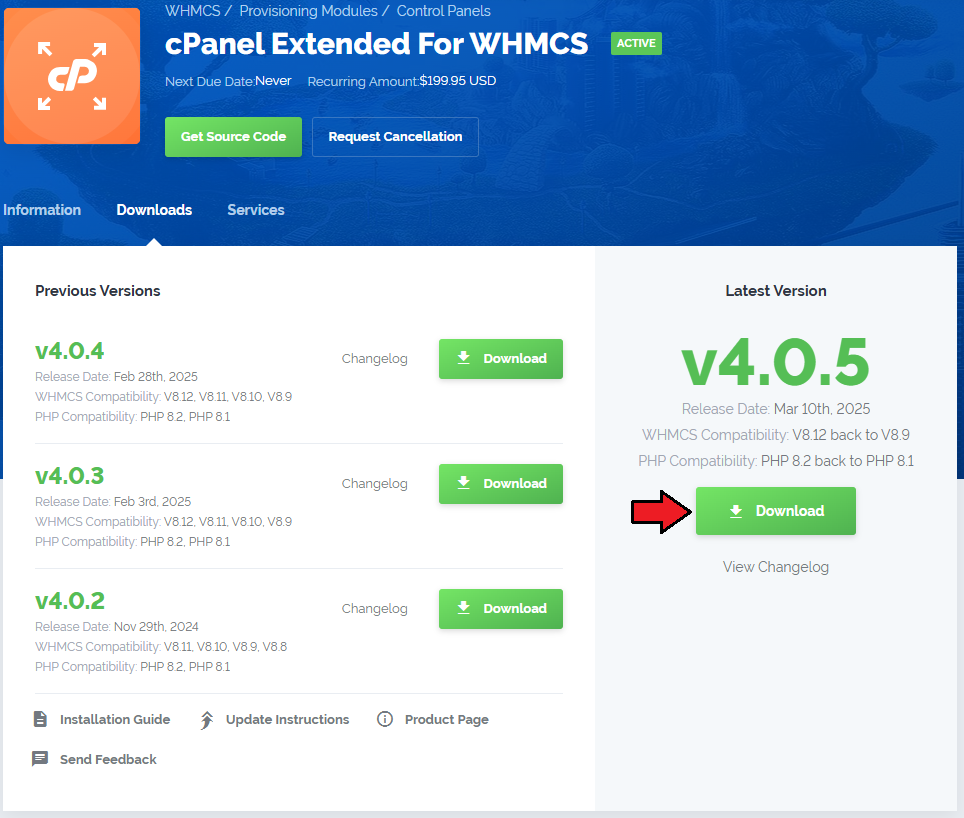
|
| 2. Upload and extract the module into the main WHMCS directory. Files in your WHMCS directory should look like this. |
| 3. When you install cPanel Extended for the first time you have to rename 'license_RENAME.php' file. File is located in 'modules/servers/cpanelExtended/license_RENAME.php' . Rename it from 'license_RENAME.php' to 'license.php' . |
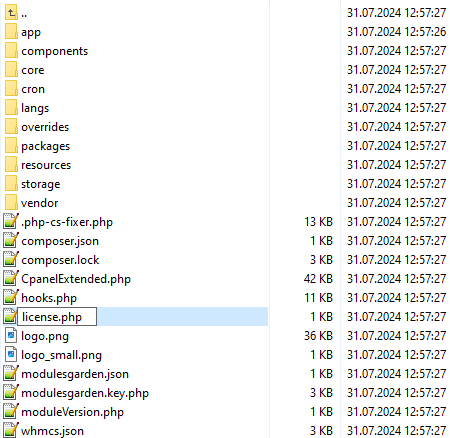
|
| 4. In order to configure your license key you have to edit a previously renamed 'license.php' file. Enter your license key between quotation marks as presented on the following screen. You can find your license key in your client area → 'My Products' . |

|
Activation of Addon
| 5. Now you have to activate the module in your WHMCS system. Log in to your WHMCS admin area. Click 'Setup' then choose 'Addon Modules' . |
| Afterwards, find 'cPanel Extended Functions' and press 'Activate' button. |
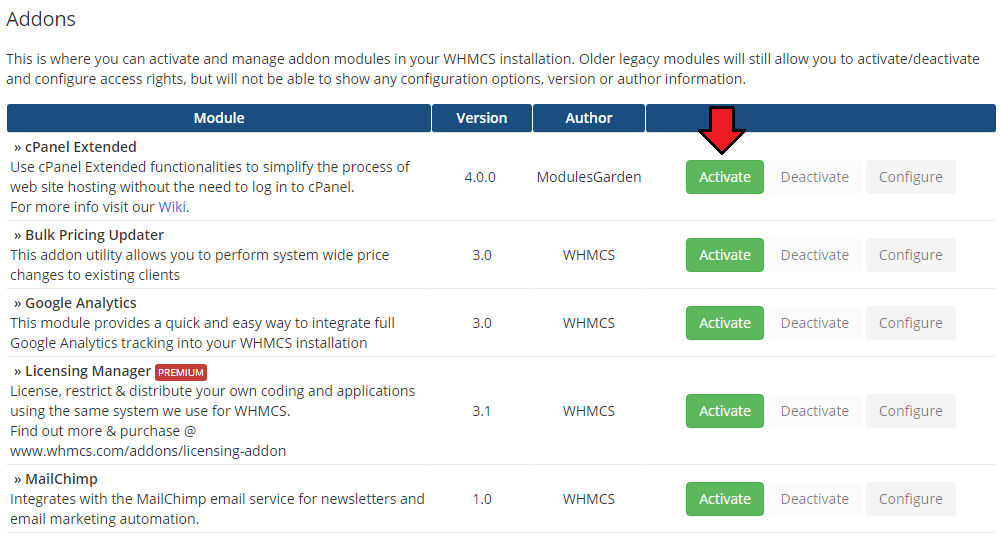
|
| 6. In the next step you need to permit access to this module. To do so, click on 'Configure' button, tick desired admin roles and press 'Save Changes' . |
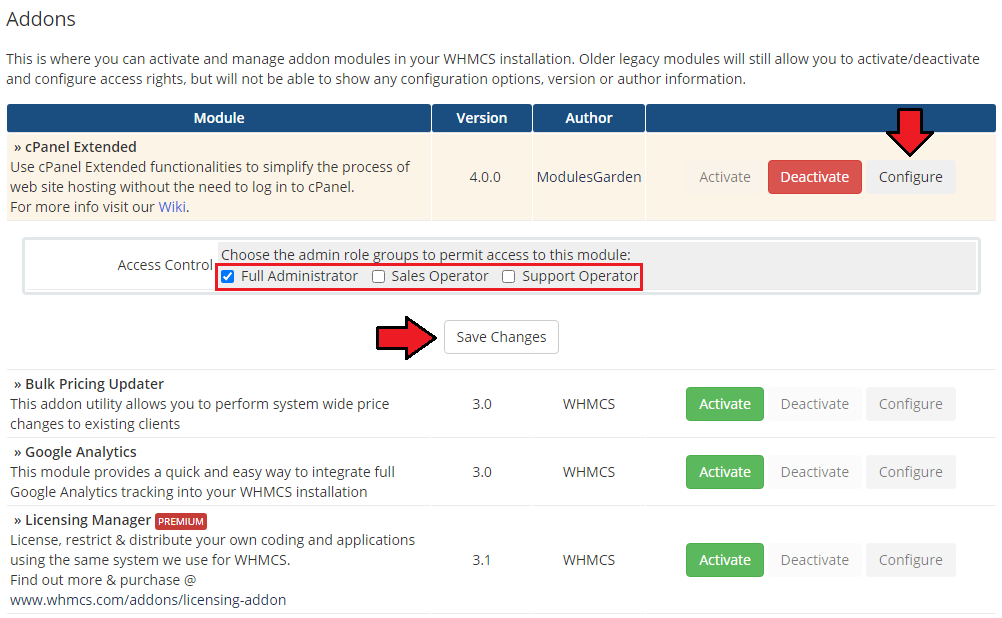
|
| 7. Well done! You have just successfully installed cPanel Extended For WHMCS! You can access the addon under 'Addons' → 'cPanel Extended Functions' . |
| File:CP7.png |
Configuration of Server
| 8. Now, we will show you how to configure a new product. Go to 'Setup' → 'Products/Services' → 'Servers' . |
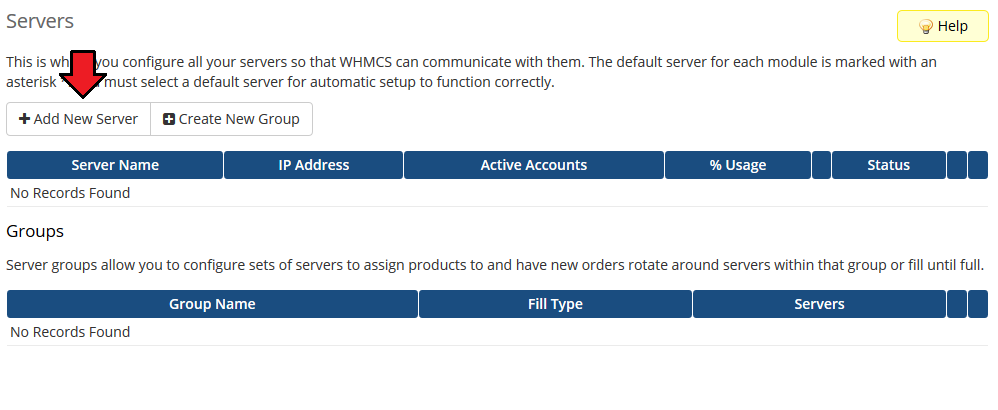
|
| 9. Next, enter your server name, IP address, username and password. Choose 'cpanelExtended' from a dropdown menu and press 'Save Changes' . If you connect with your cPanel server via SSL then make sure that you checked 'Secure' located at the bottom of the page. |
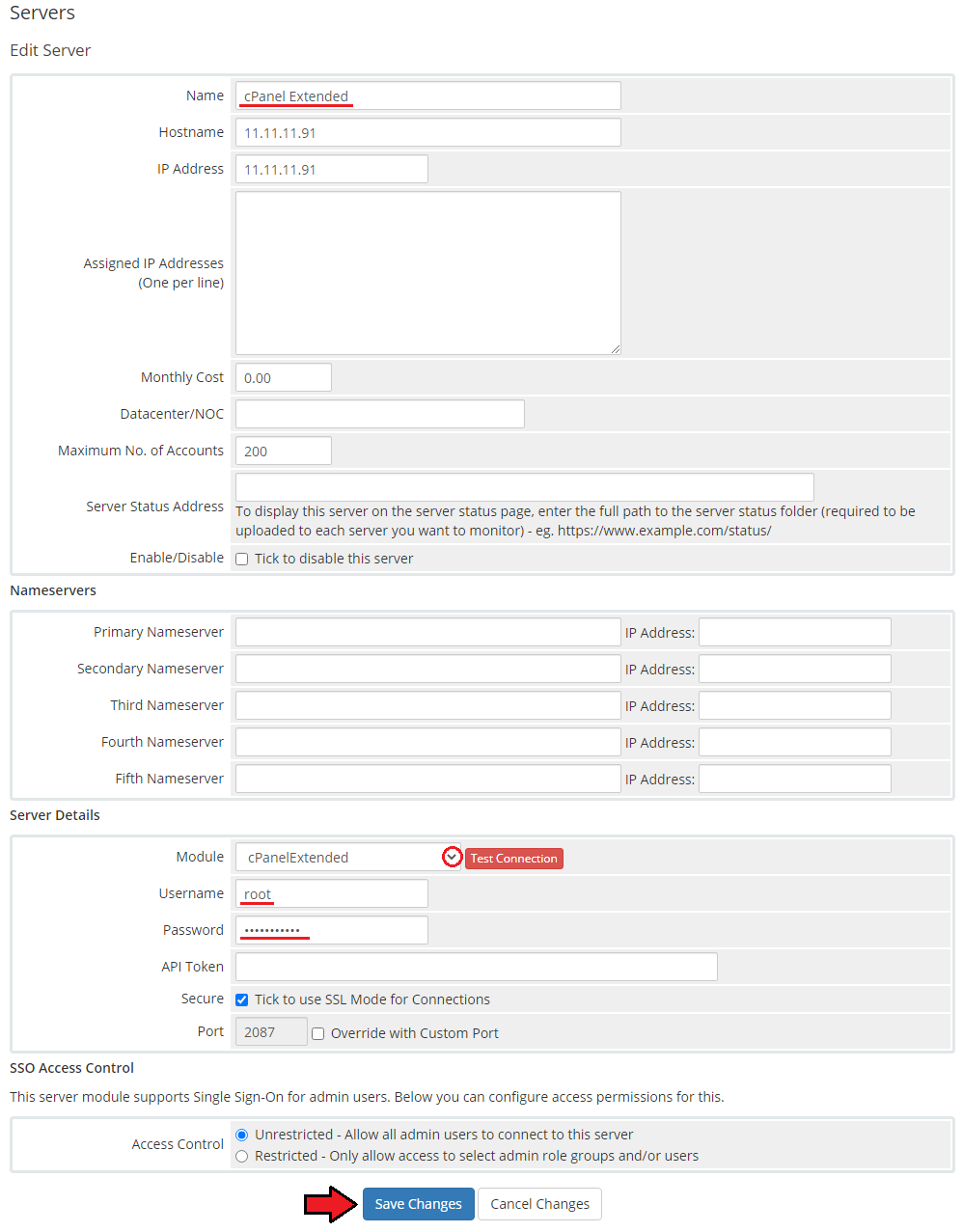
|
| 10. After configuring your server correctly, you will see a following screen. Now you need to create a new group for your server. For that purpose press 'Create New Group' . |
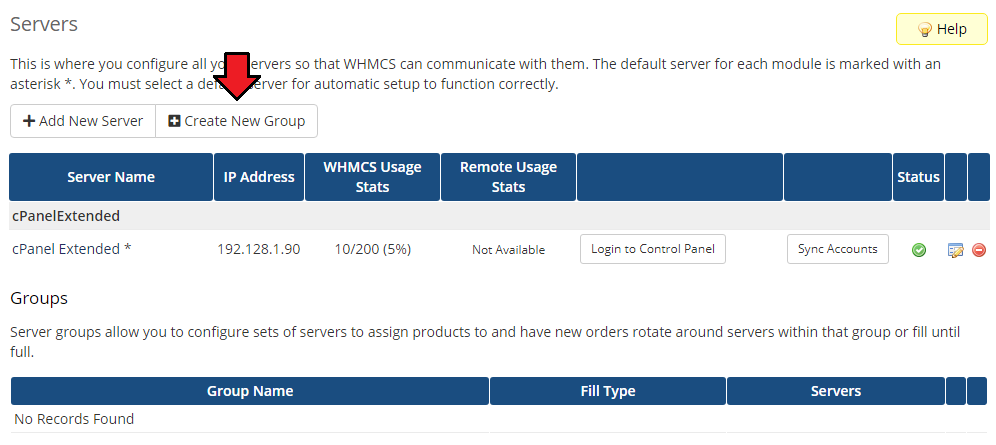
|
| 11. Enter name, click on your previously created server, press 'Add' then 'Save Changes' . |
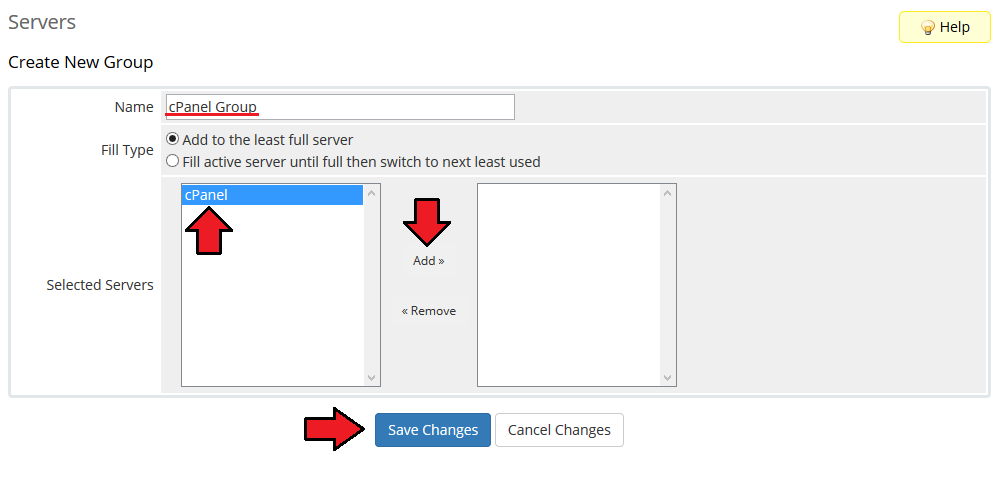
|
Configuration of Product
| 12. In order to create a product, go to 'Setup' → 'Products/Services' → 'Products/Services' . If you don't have a product group, click on 'Create a New Group' . If you do, simply go to step 14. |

|
| 13. Fill in a product group name and press 'Create Group' . |
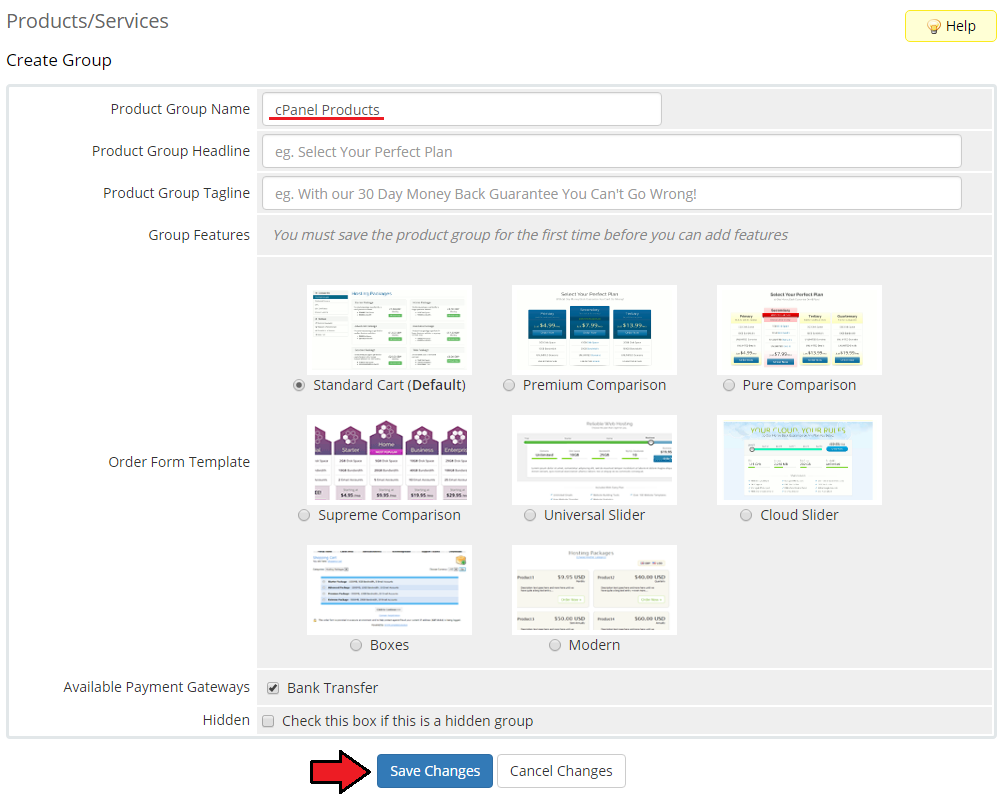
|
| 14. When you have a product group, you can create your product and assign it with cPanel Extended module. |

|
| 15. Afterwards, choose your product type and product group from dropdown menus, enter your product name and press 'Continue' . |
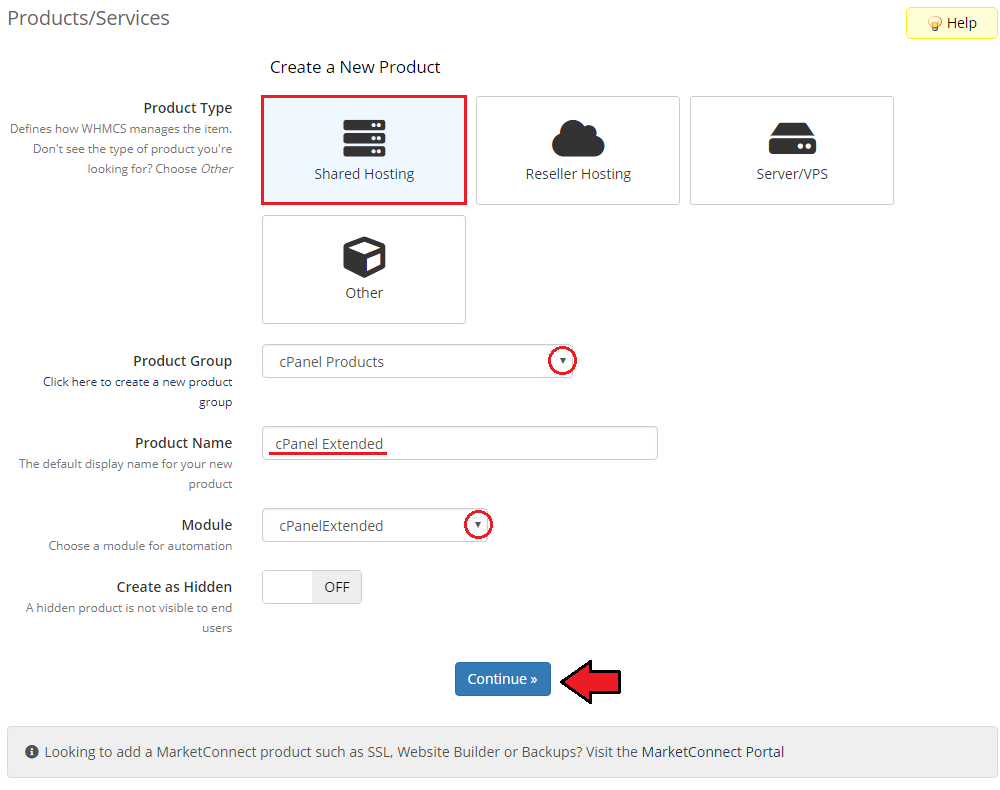
|
| 16. Now, go to 'Module Settings' section, choose both 'CpanelExtended' and a previously created server group from dropdown menus and press 'Save Changes' . You can also configure your WHM Package here. |
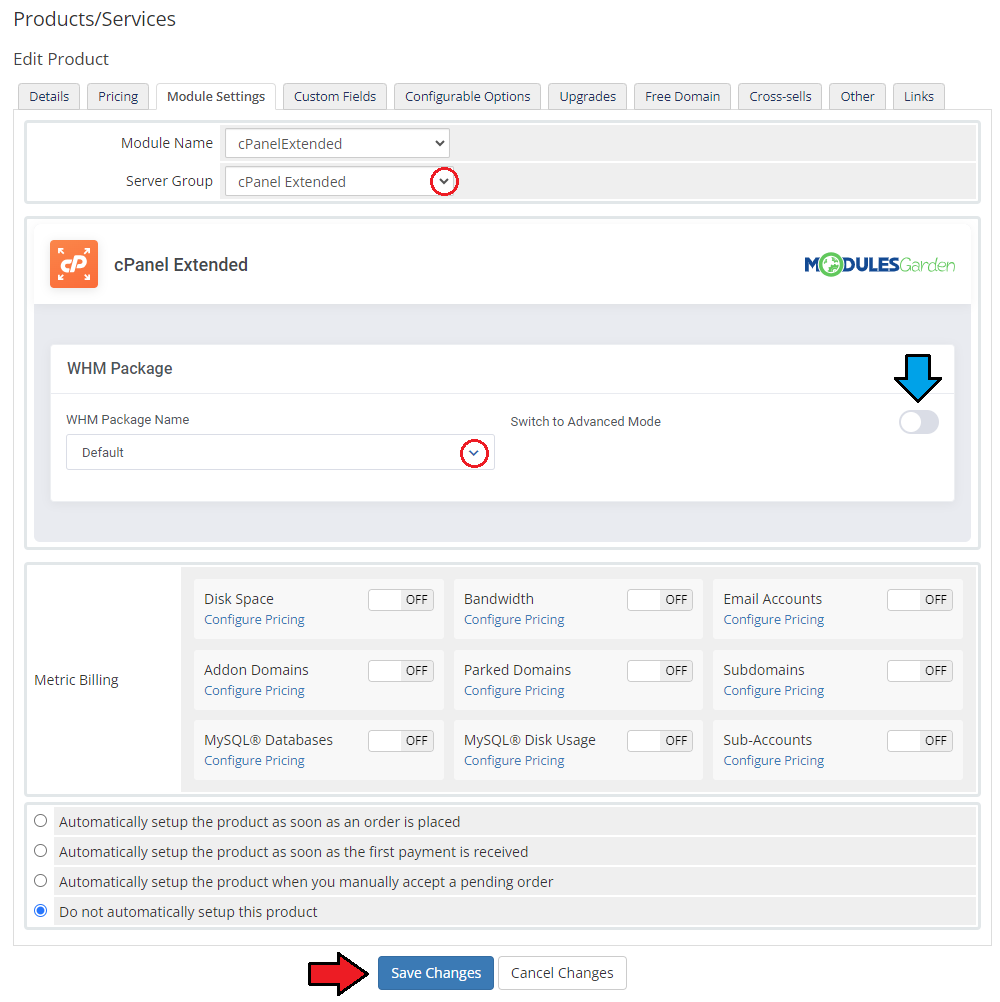
|
Configuration of Addon
| 17. You have just correctly created and customized a new product. Now, you can define features available in the client area per cPanel Extended product. |
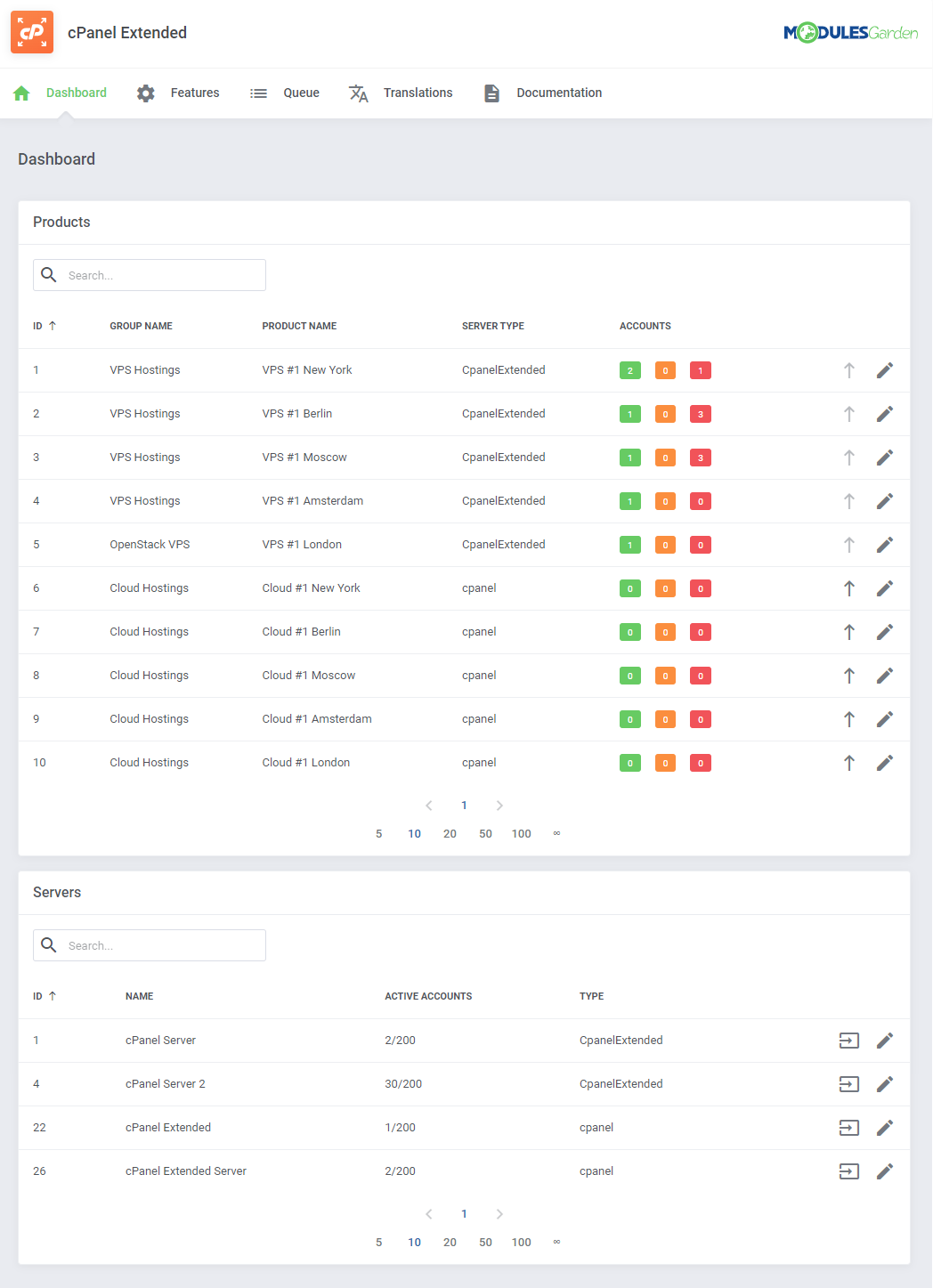
|
| 18. Now, tick the features you would like to activate for your customers and press 'Save Changes' button. |
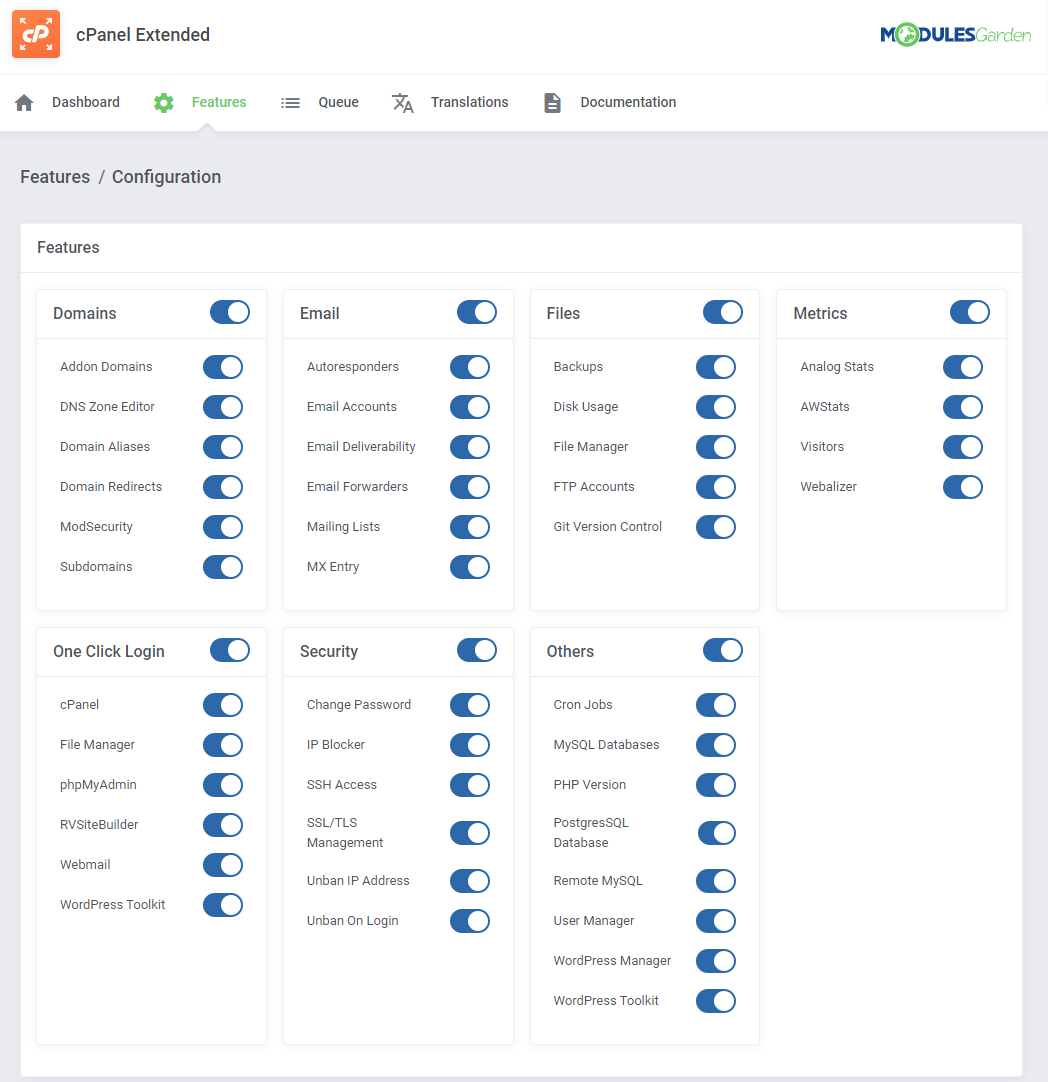
|
| 19. Now, press 'Install Apps' button. |
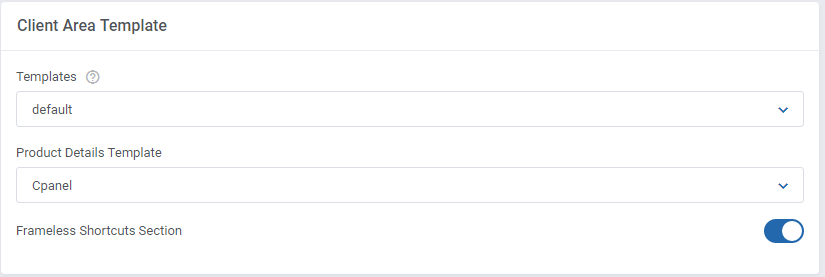
|
| 20. Tick 'Install App' , choose your Auto Installer from a dropdown menu. Afterwards tick 'Install Button' and 'Backup Button' . You can also choose desired language of the applications by entering value into the 'Language' field. Complete list of language codes can be found here. |
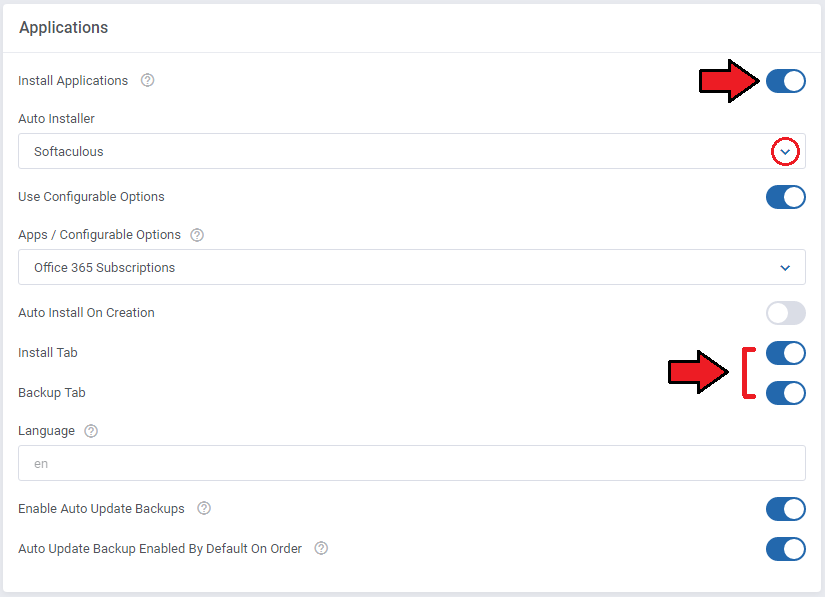
|
| 21. From now on, all your clients who ordered a previously created product will be able to manage their cPanel accounts via your WHMCS system. This is what your customers should see in their client area: |
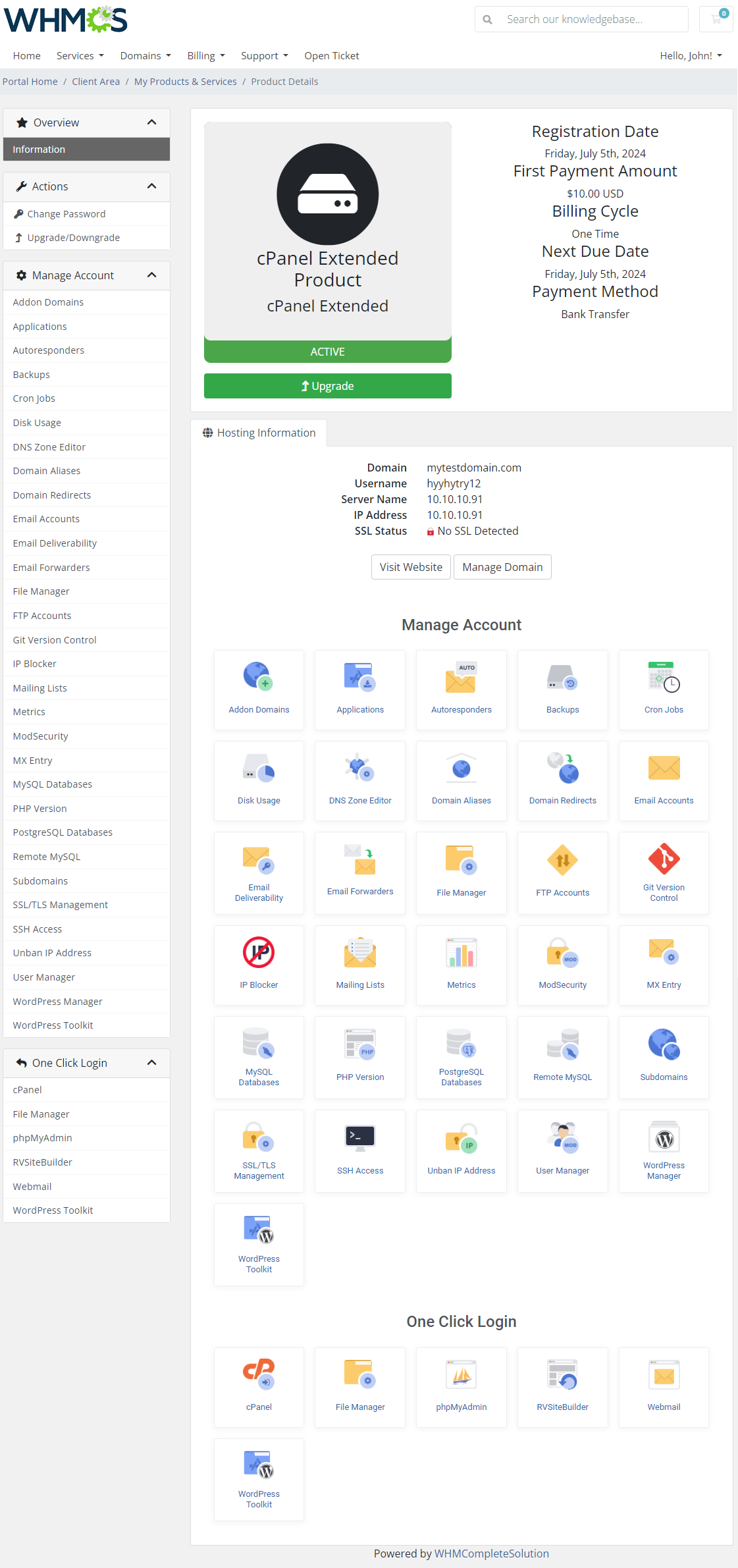
|
Management
| cPanel Extended allows your customers to manage their cPanel account via the client area of your WHMCS system. In this short guide we will present you the possibilities of our module. |
Client Area
| This section shows features available in the client area. |
FTP Accounts
| You can manage your FTP accounts through creating, modifying and deleting them. |
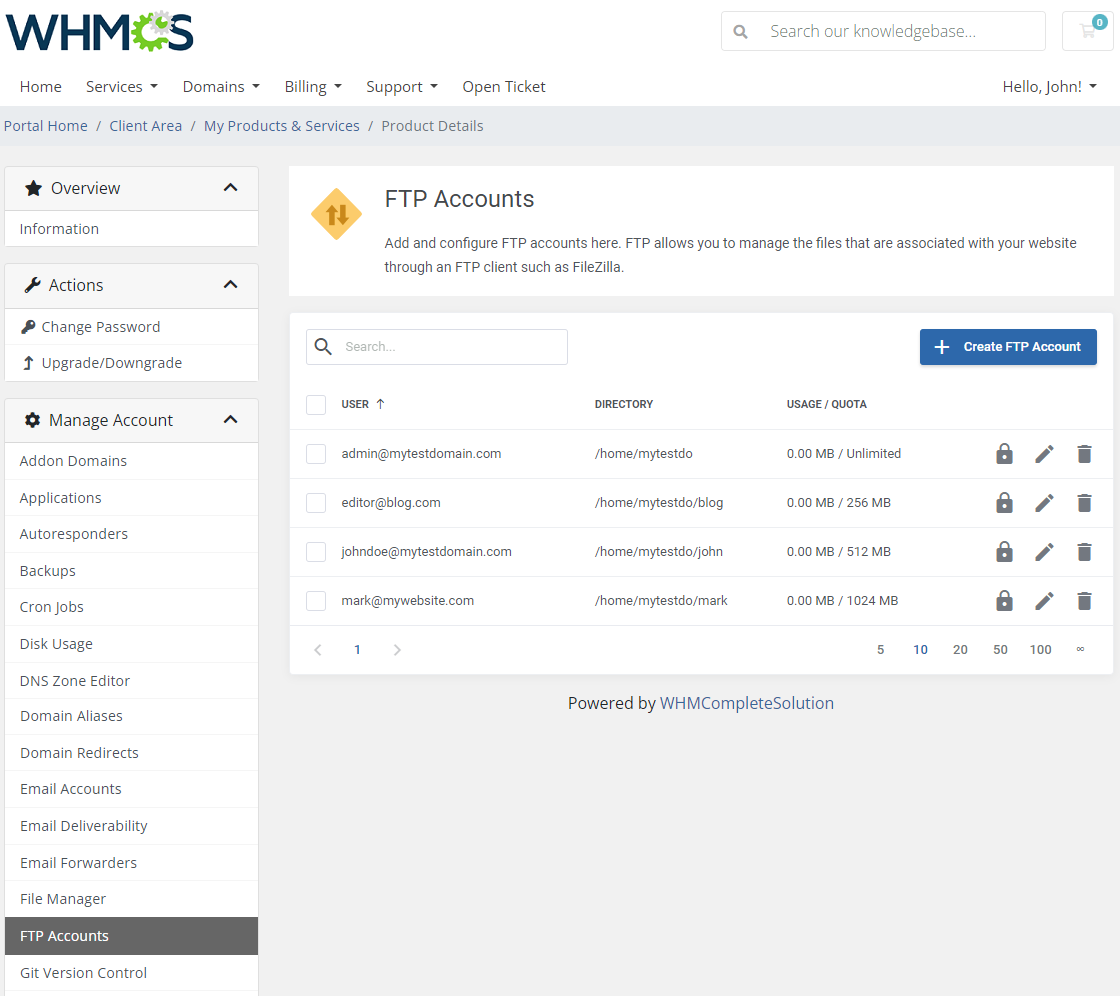
|
Files
| Files page, as its name suggests, allows you to view and manage files and folders of your cPanel account. |
| File:CP22 1.png |
SSH Management
| Here, you can configure your SSH keys pair. Afterwards, you can connect to your cPanel, for example via PuTTY, with your private SSH key. |
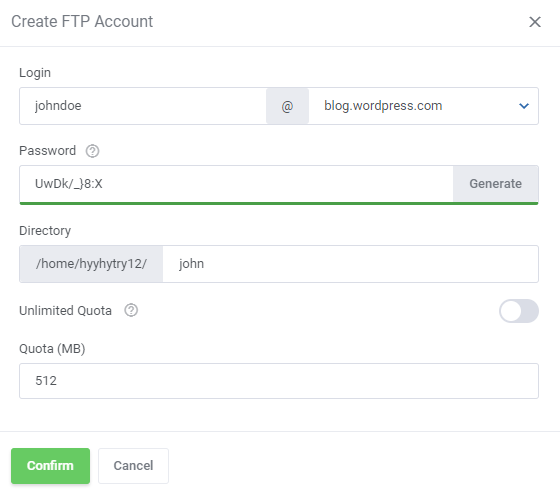
|
MX Management
| This page enables you to manage your MX records for each of your domains. |
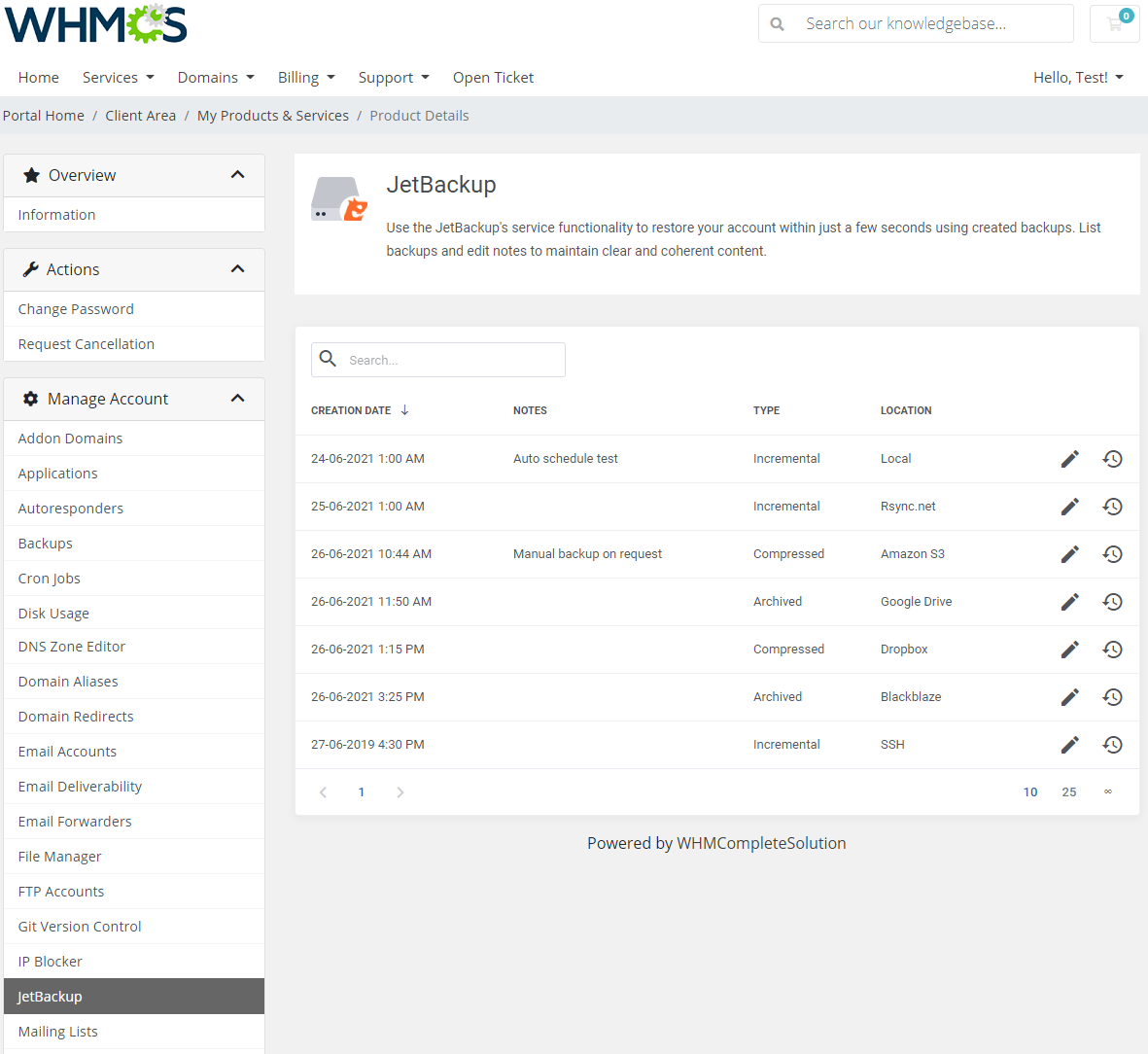
|
Emails
| In this page you can manage all aspects related to email accounts. |
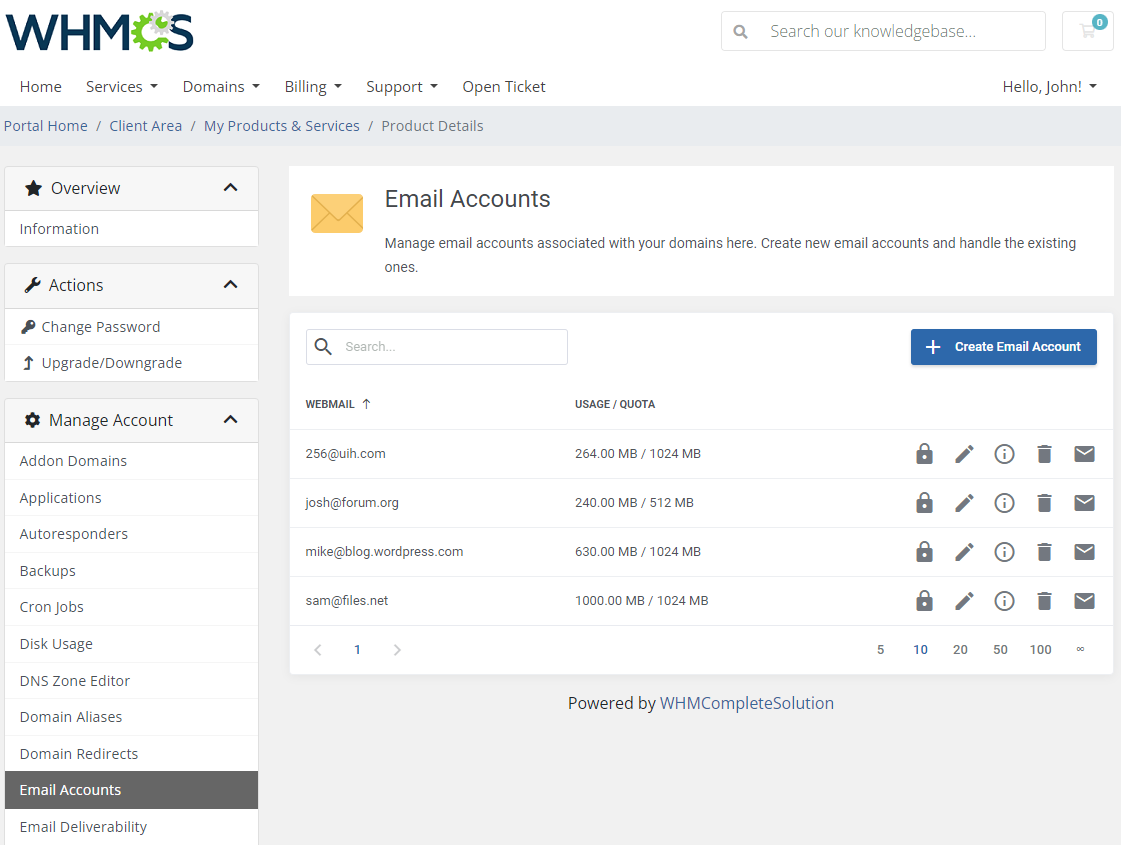
|
Email Forwarders
| Here you can set up email forwarders and email domain forwarders. |
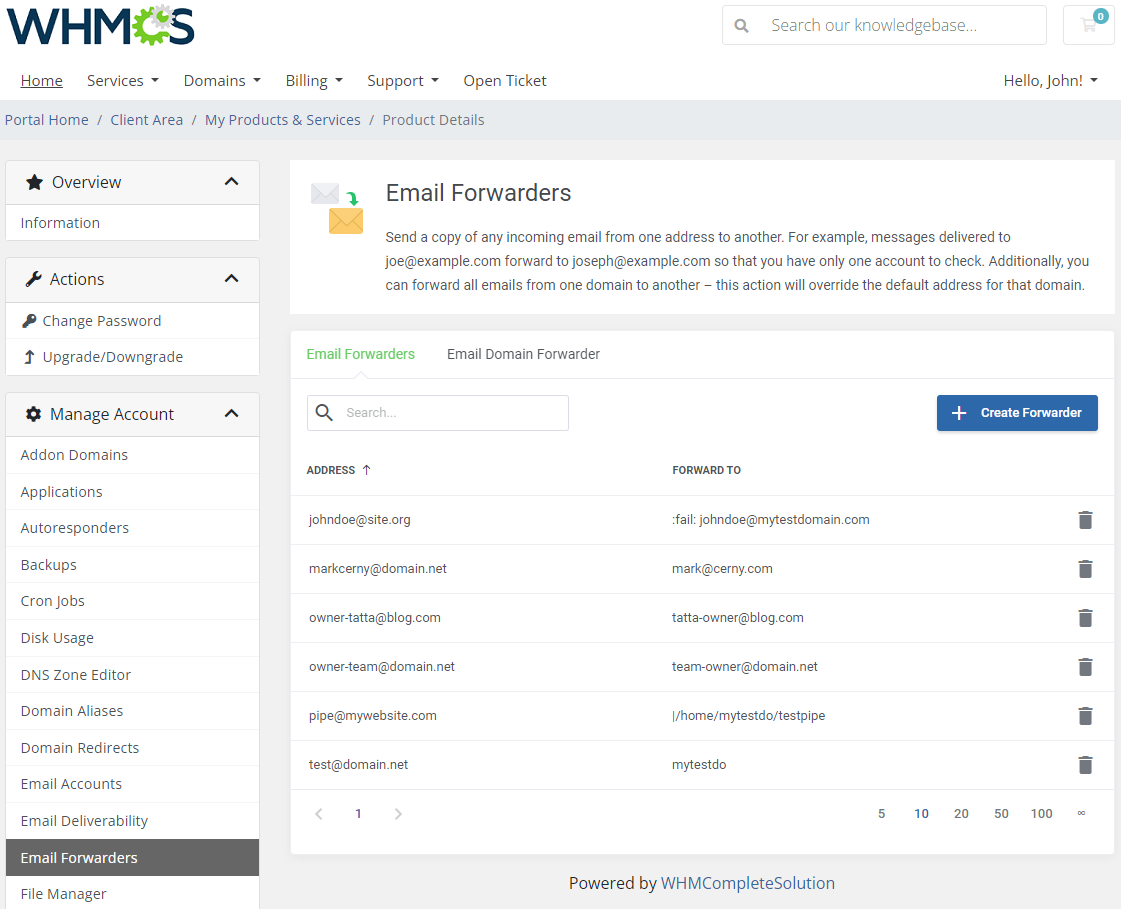
|
Databases
| Owing to MySQL Databases Management you can create/delete databases and users. You can also assign users to particular databases and set up their privileges. |
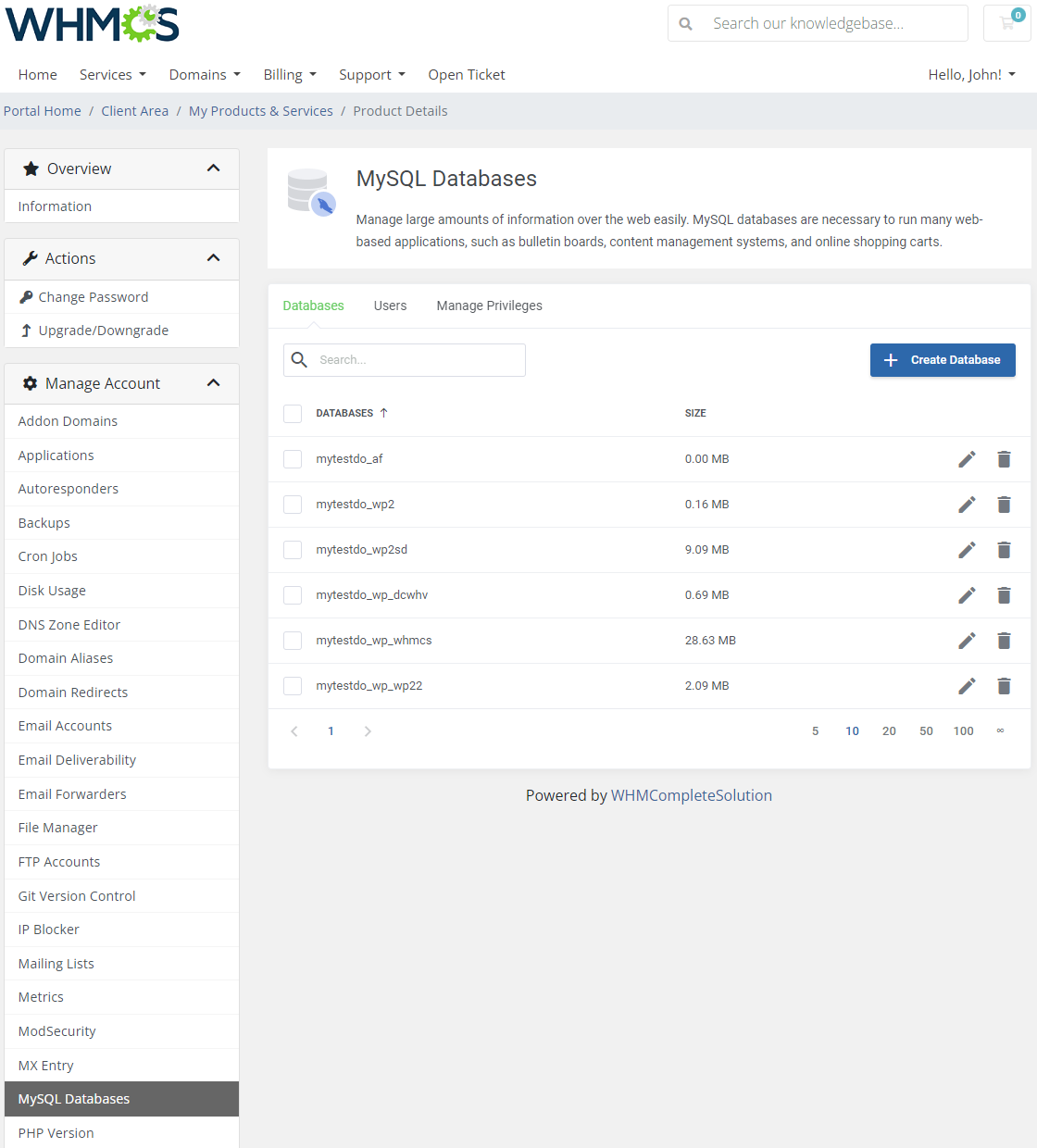
|
Cron
| Management of cron allows you to add and monitor your cron jobs. |
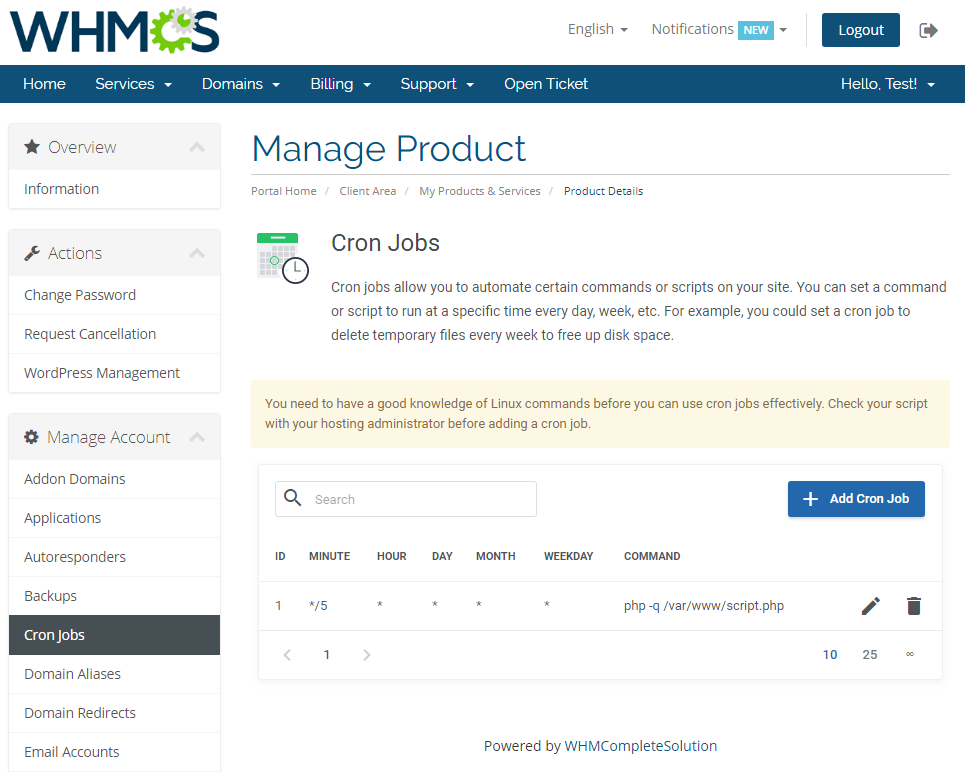
|
Subdomains
| You can create and manage subdomains of your domain. |
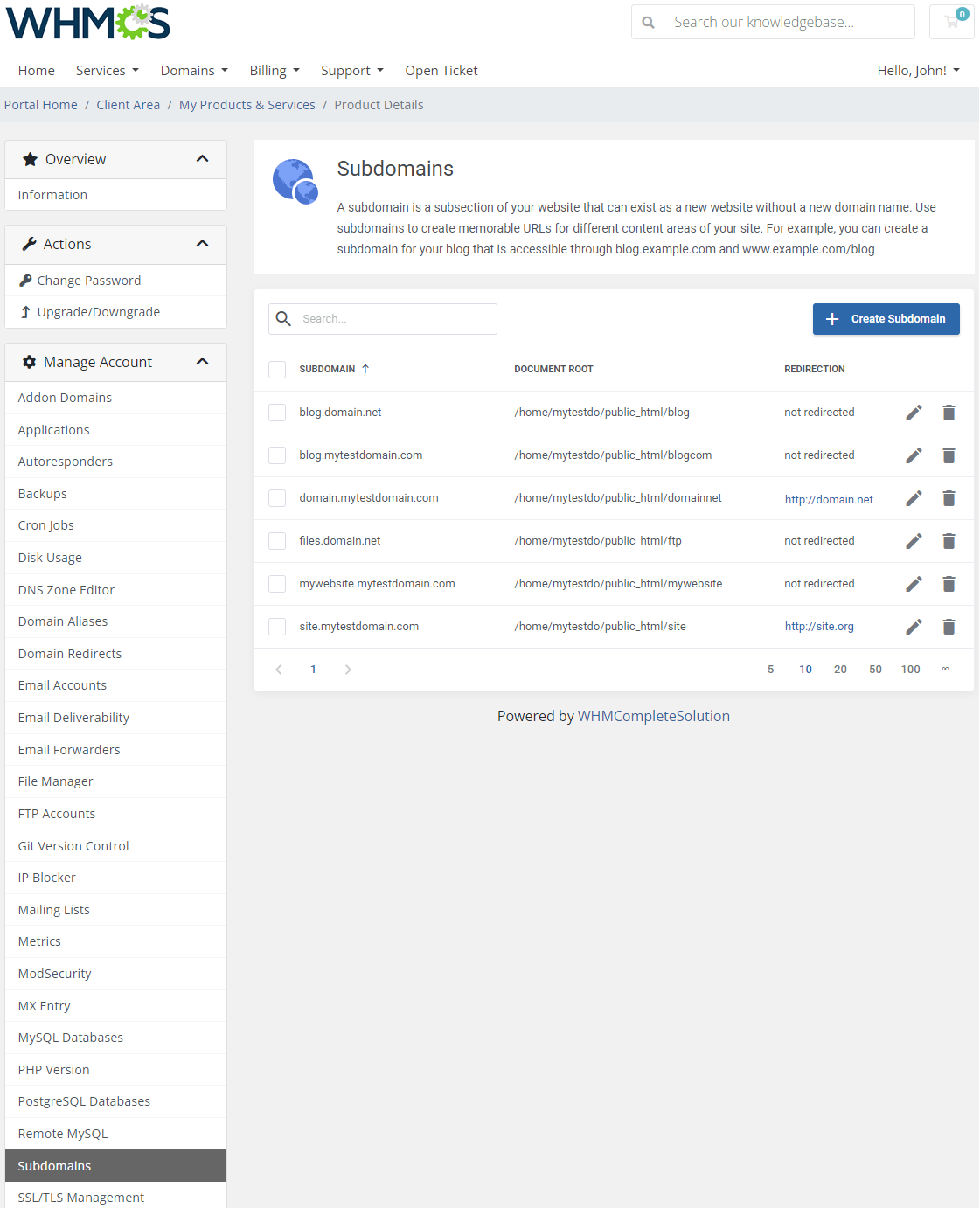
|
Addon Domains
| Addon domains management is available on this page. Addon domains allow you to link the domain to a subdirectory of your account. |
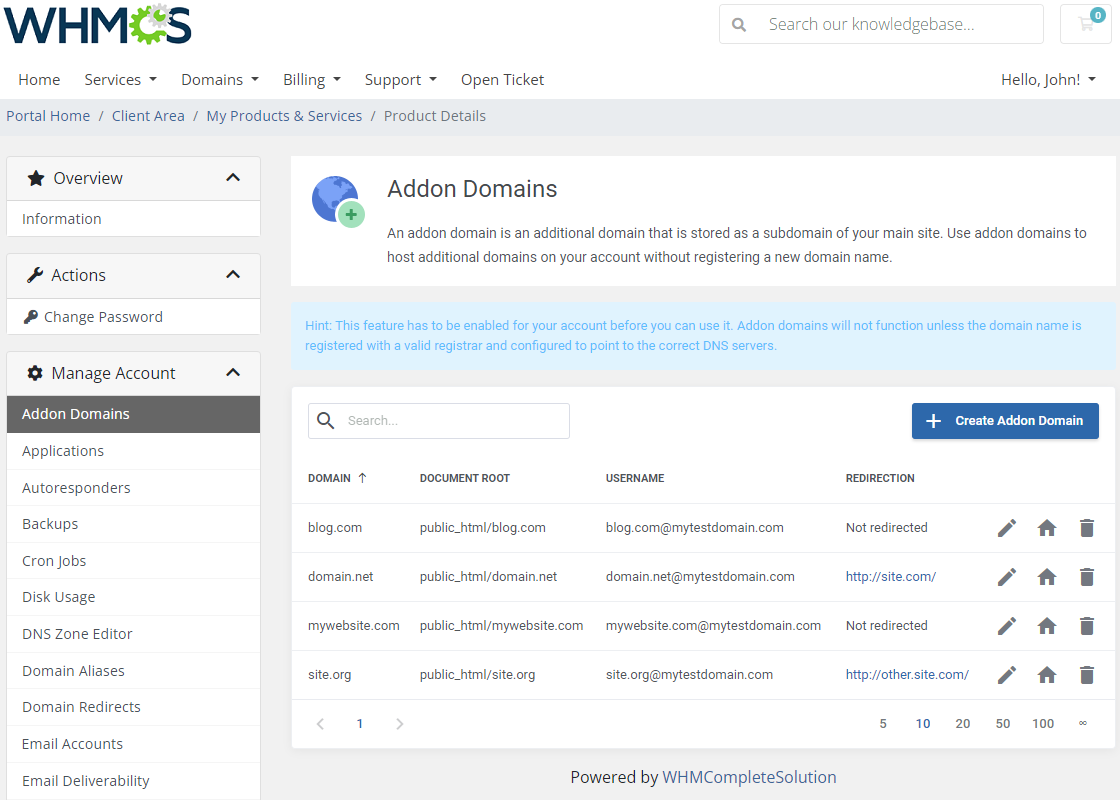
|
Parked Domains
| You can add and manage your parked domains. Parked domains allow you to point to another domain of your account. |
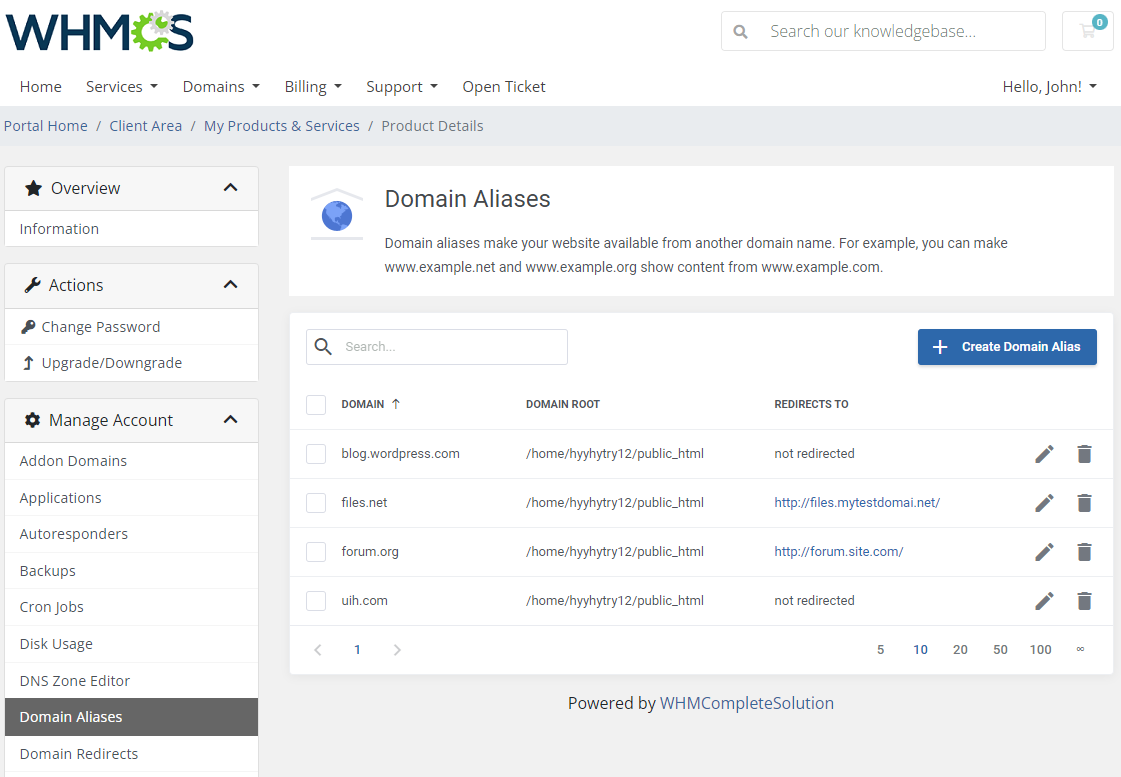
|
Domain Forwarders
| Easy access to domain forwarders is very useful. Within a few seconds, you can redirect the page to point to another. Redirect option allows you to make a specific web page redirect to another page and display the contents of that page. |
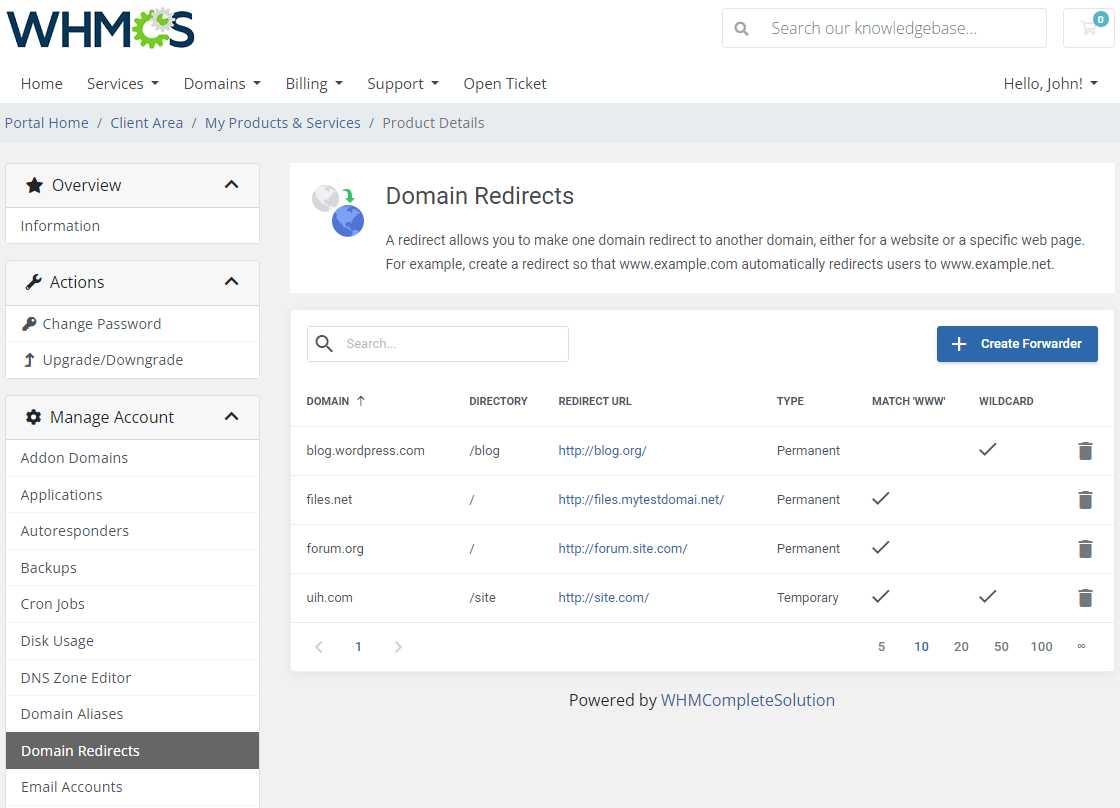
|
Stats
| Owing to Webalizer, AWstats, Analog Stats and Latest Visitors, you can always be up to date with information about your websites. |
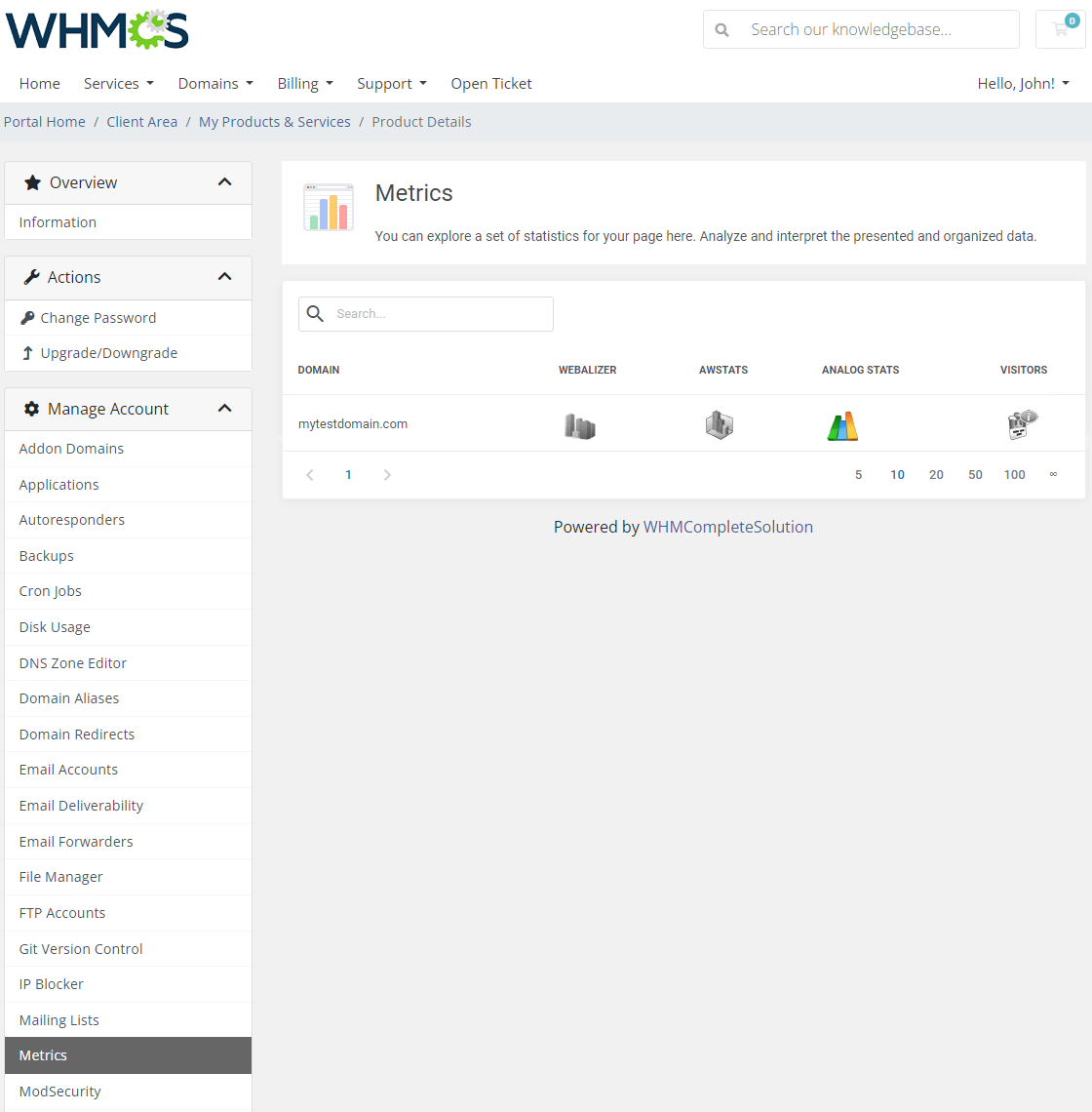
|
Backups
| You can make backups and download your whole cPanel settings or only a part of them. To generate a full backup, press 'Download or Generate Full Website Backup' . |
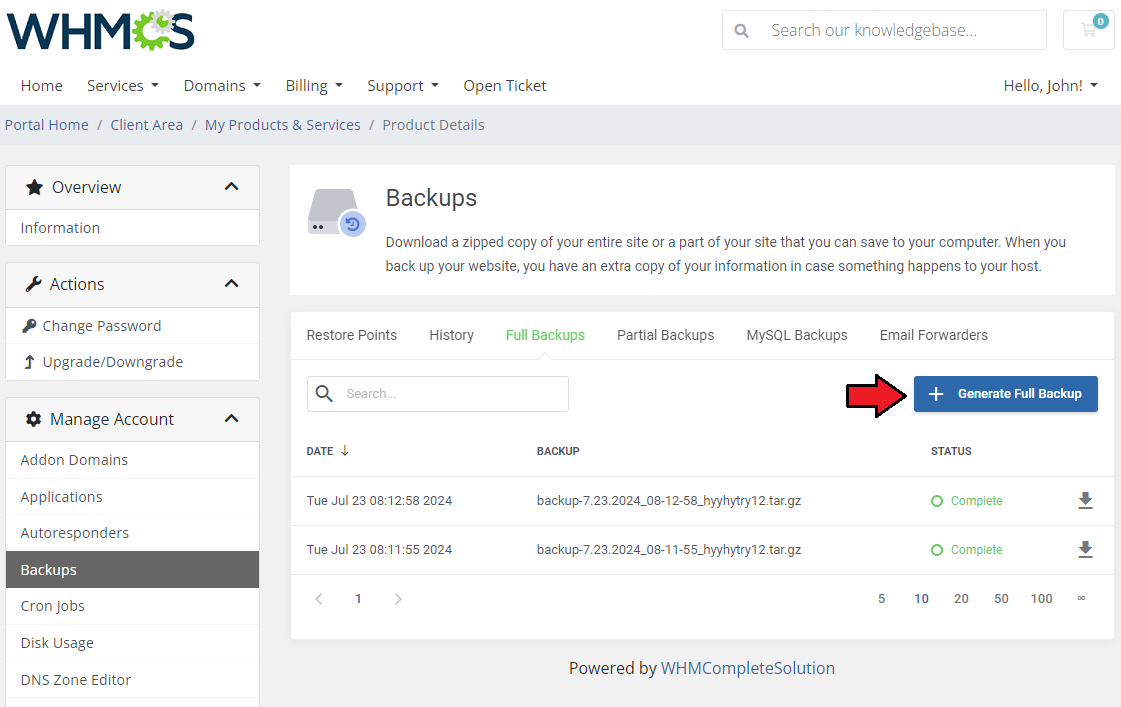
|
| Afterwards, choose 'Backup Destination' from a dropdown menu. Optionally, you can fill in an email address, where a notification about the backup will be sent. |
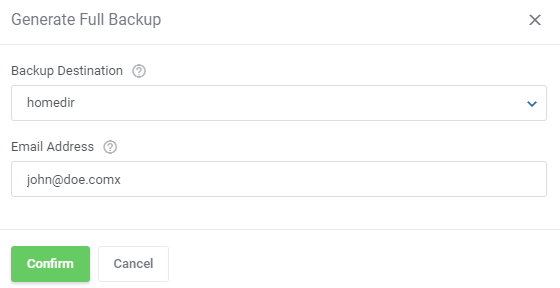
|
| To download a backup, simply press its name. Download should start immediately. Partial backups are generated during the download process. |
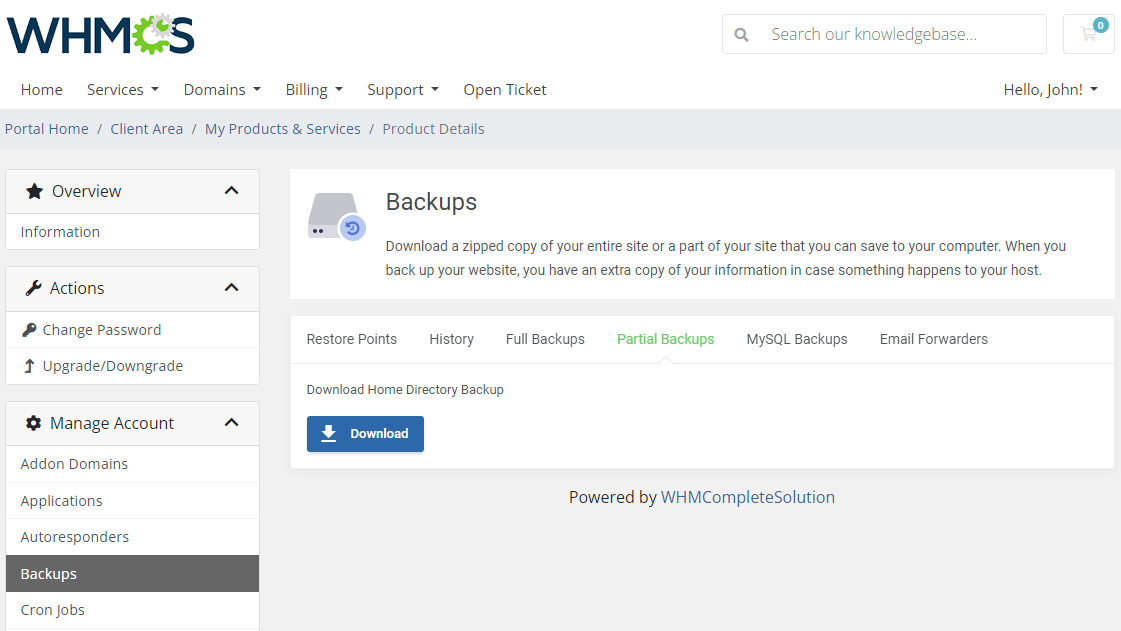
|
SSL Certificates
| This feature moves completely the management of your Private Keys, CSR Keys and SSL Certificates into your WHMCS client area. Here you can conveniently manage all the aspects of your SSL Certificates without the necessity of logging in to your cPanel. |
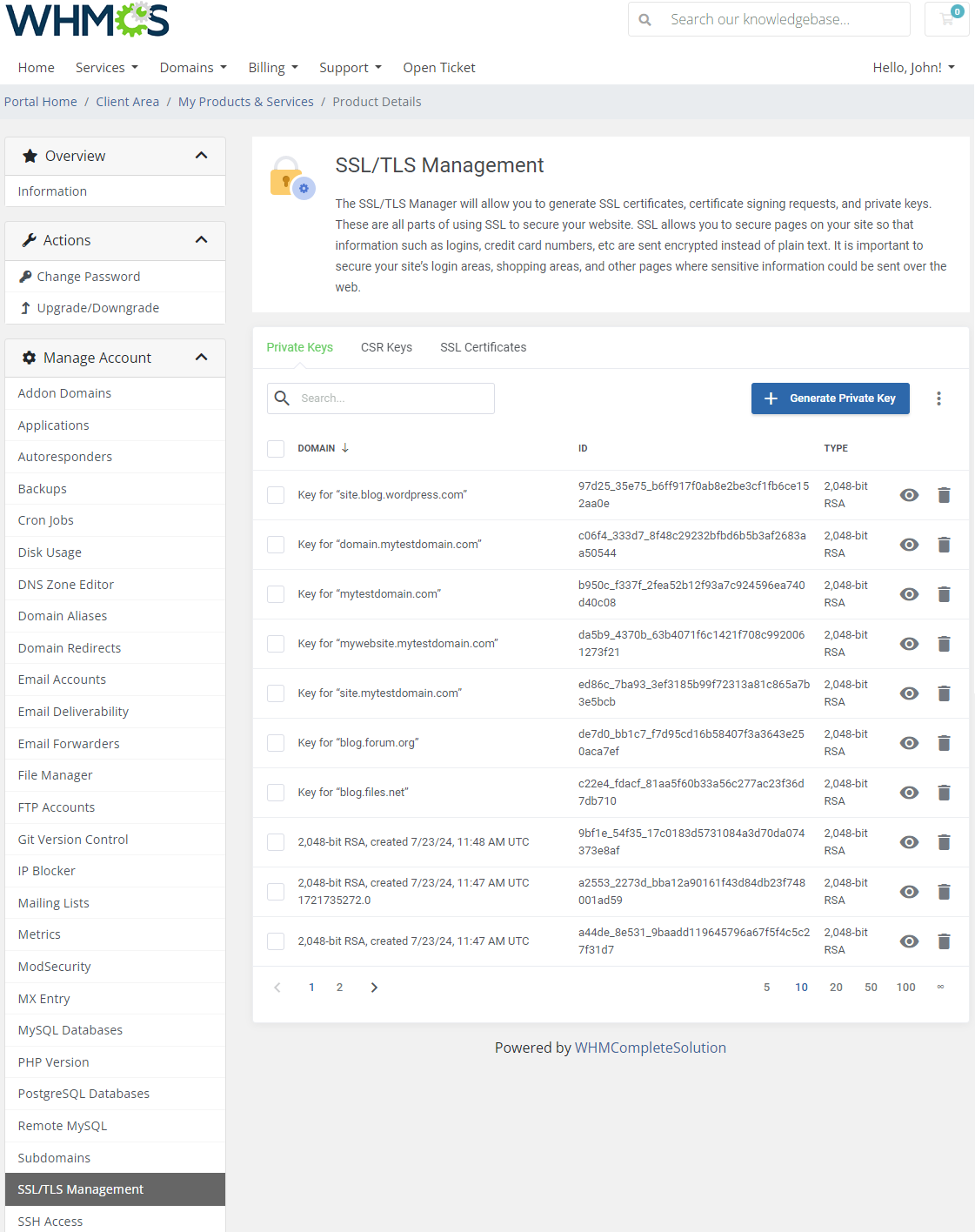
|
Unban IP
| In 'Unban IP' page you can unban IP addresses banned by your system. To unban IP address, simply enter it into 'IP Address' textbox and press 'Unban' button. |
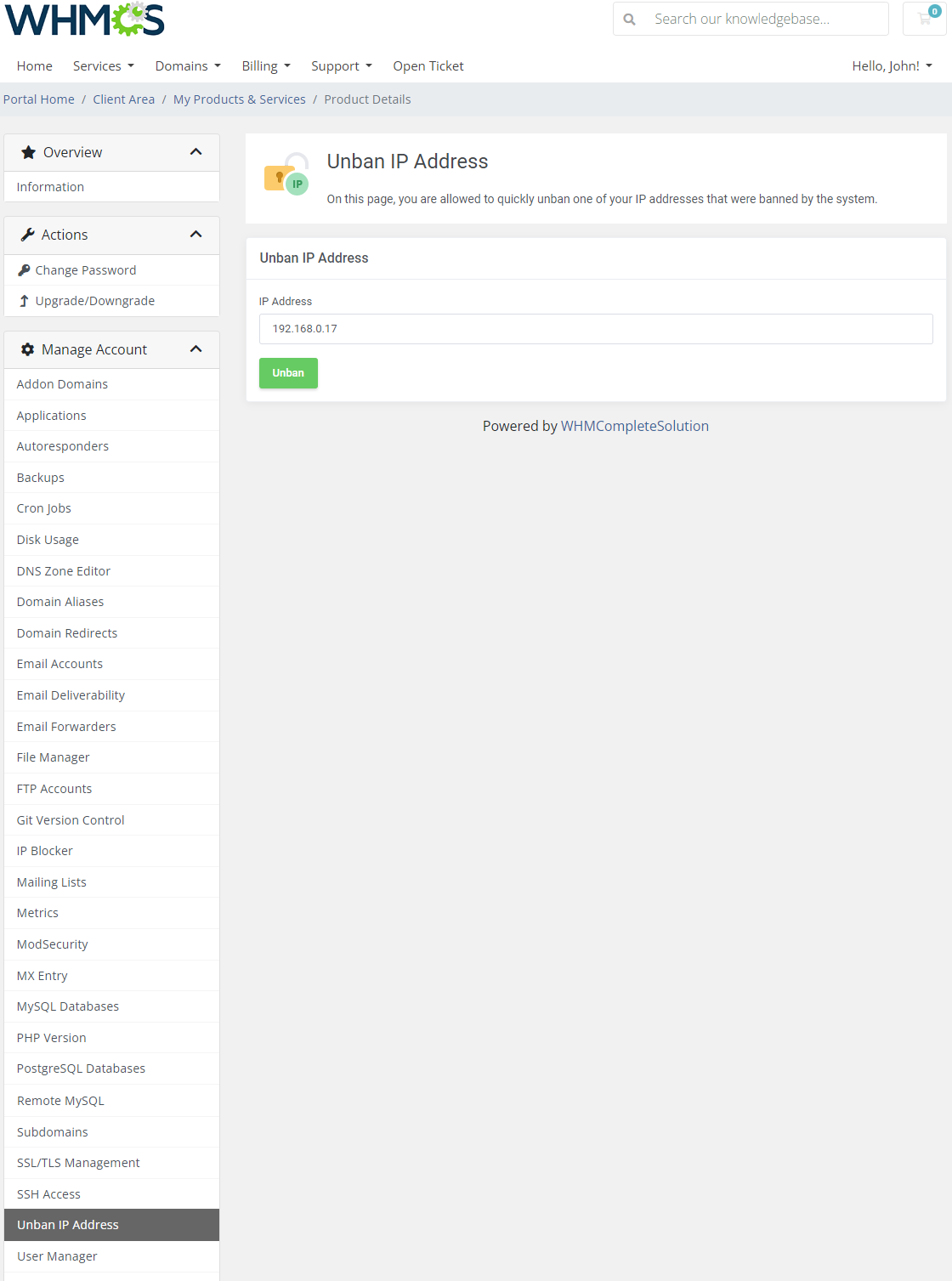
|
Log In To phpMyAdmin
| Get quick access to your phpMyAdmin with just one click. You don't even need to fill in your username and password! |
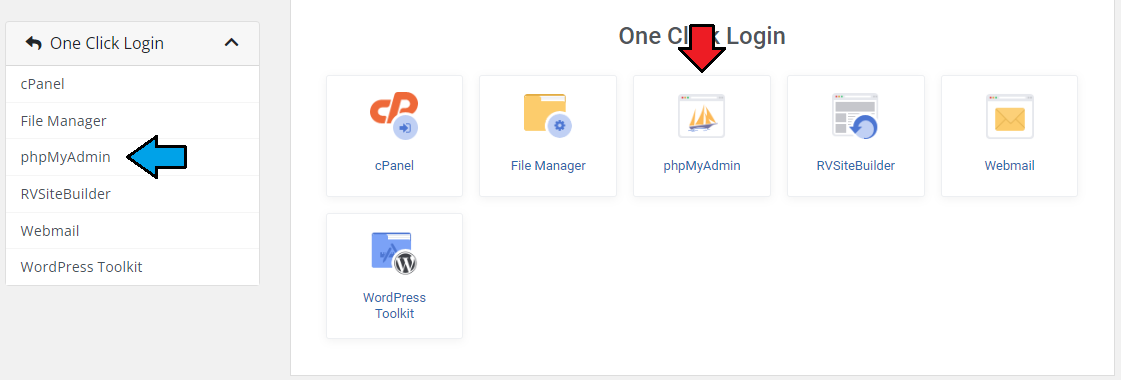
|
Log In To cPanel
| You can easily log in to your cPanel by clicking 'Log In To cPanel' . Here, similarly to phpMyAdmin, you don't need to enter your access details! |
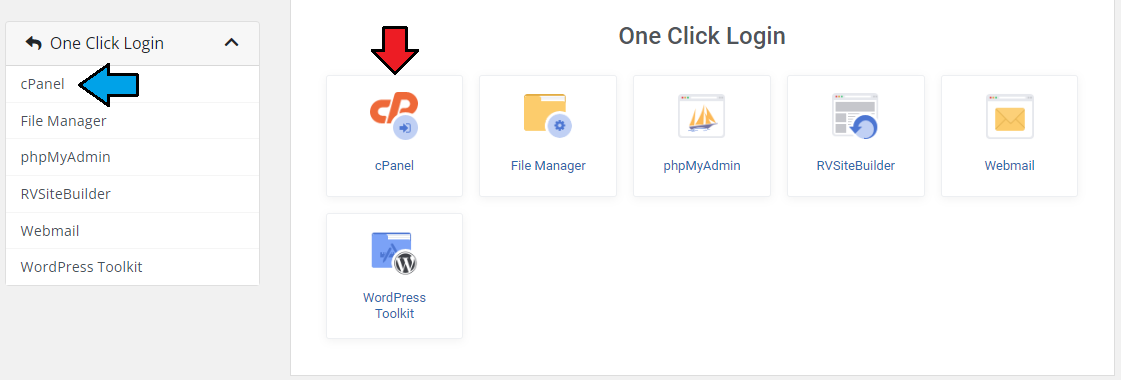
|
Log In To Webmail
| With a single click of 'Log In To Webmail' you can access your Webmail. |
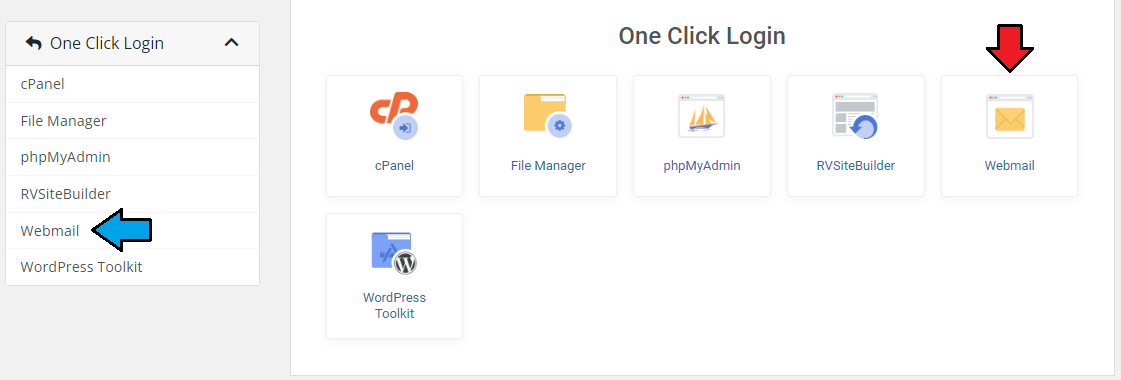
|
Log In To RVSiteBuilder
| One click of the button moves you immediately to RVSiteBuilder. |
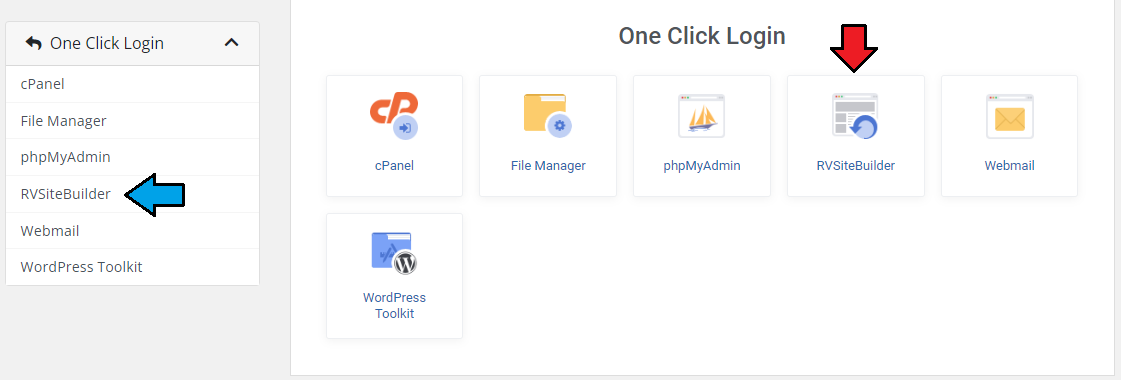
|
Log In To File Manager
| Forwards you to File Manager in your cPanel account instantly. |

|
Install Applications
| Very interesting and time saving feature of cPanel Extended. In seconds you can install your favourite applications without even accessing cPanel! To do so, simply click on 'Install Applications!' then click on 'Install New' button. |
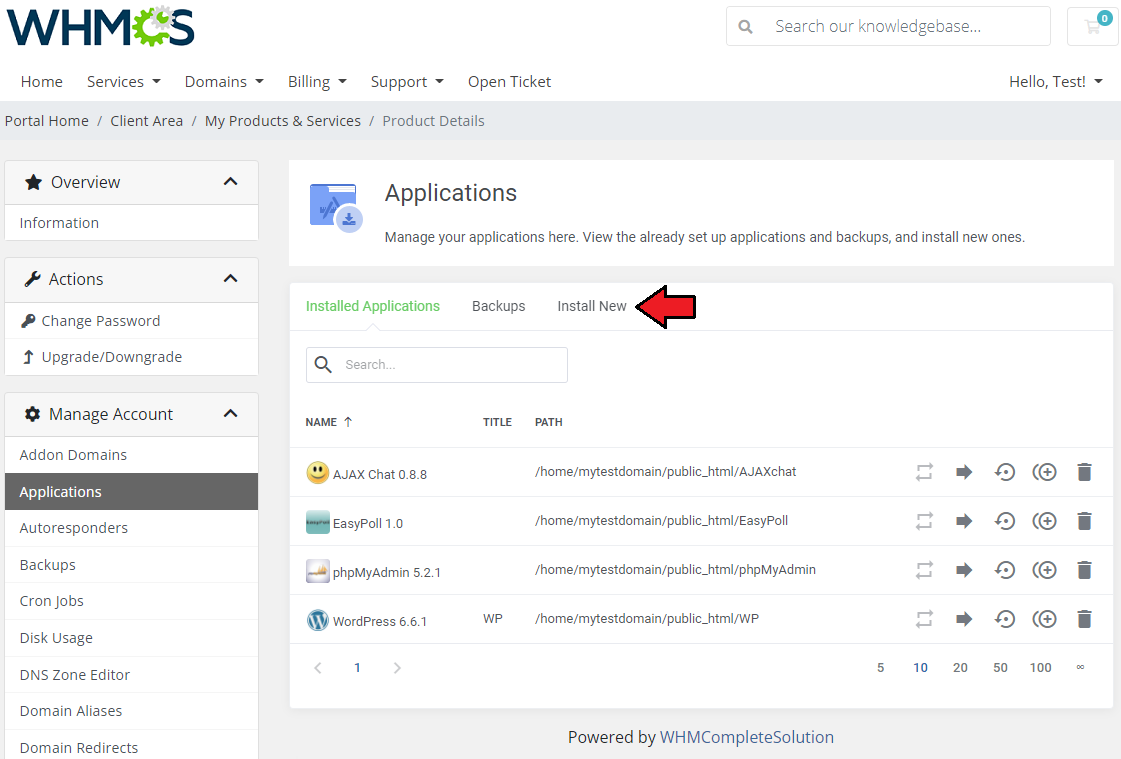
|
| Afterwards, you will see an extensive menu of application categories. For presentation purposes we will install 'Wordpress' located in 'Content Management' . Please note that the following screen doesn't contain all available applications. |
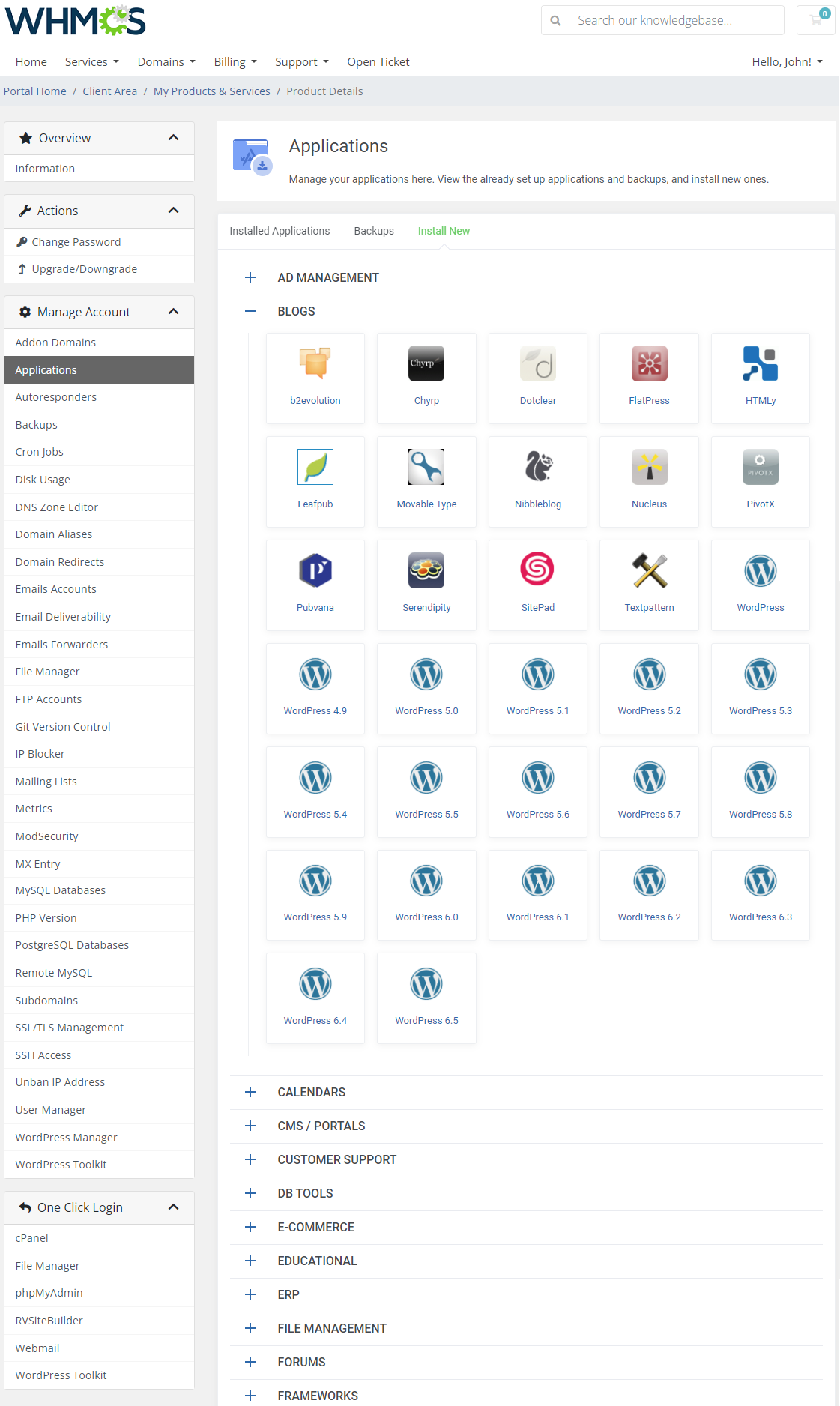
|
| Let's enter 'Content Management' category and press 'Install Now!' button next to 'Wordpress' . |
| File:CP43.png |
| Now, you can enter necessary installation details and press 'Install Application' when ready. |
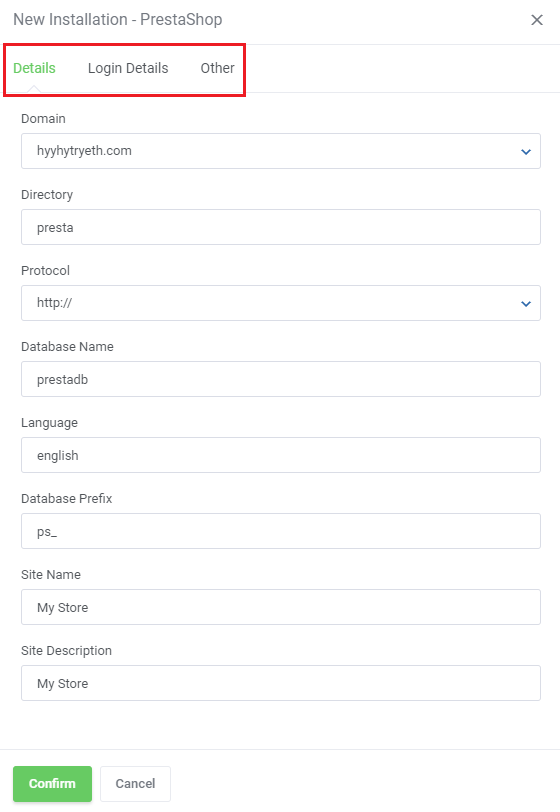
|
| If the installation process has been successful, you will see a message similar to the one shown on the screen below. |
| File:CP45.png |
| From now on you can check the status of your applications by clicking 'Install Applications!' on the left side menu. |
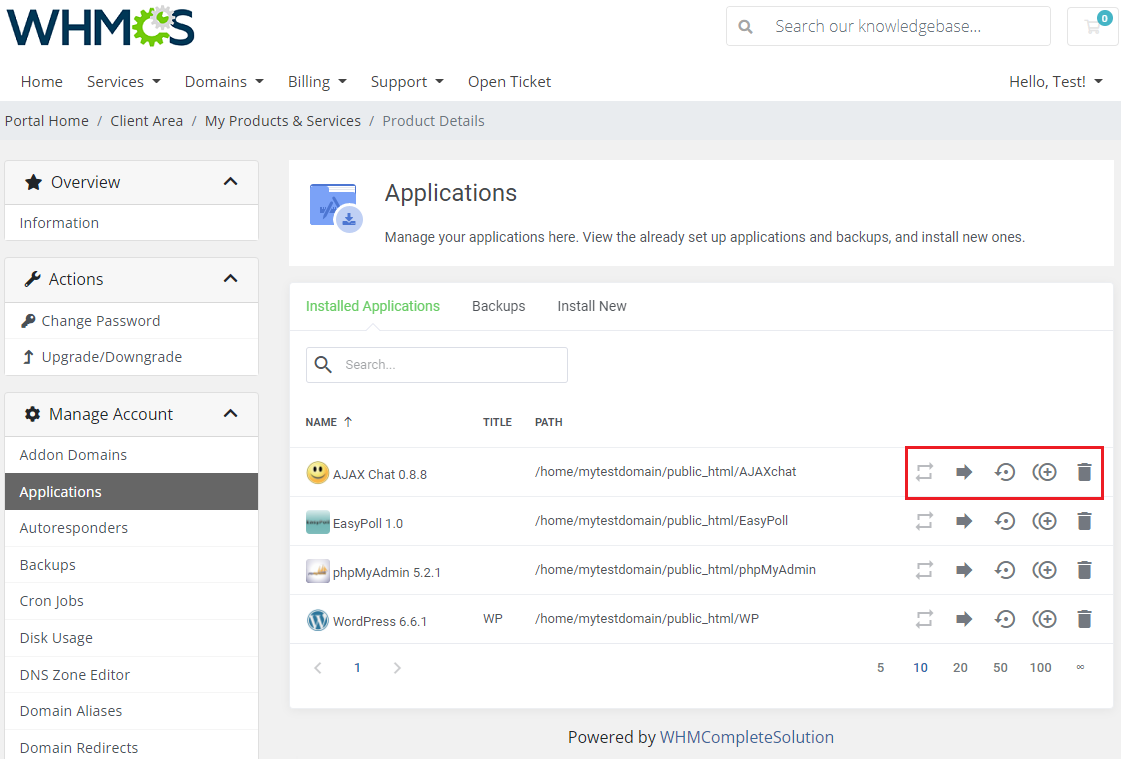
|
Backups Management For Apps
| You can also create a backup of your installation. It's very easy! To do so, click 'Manage' button. |
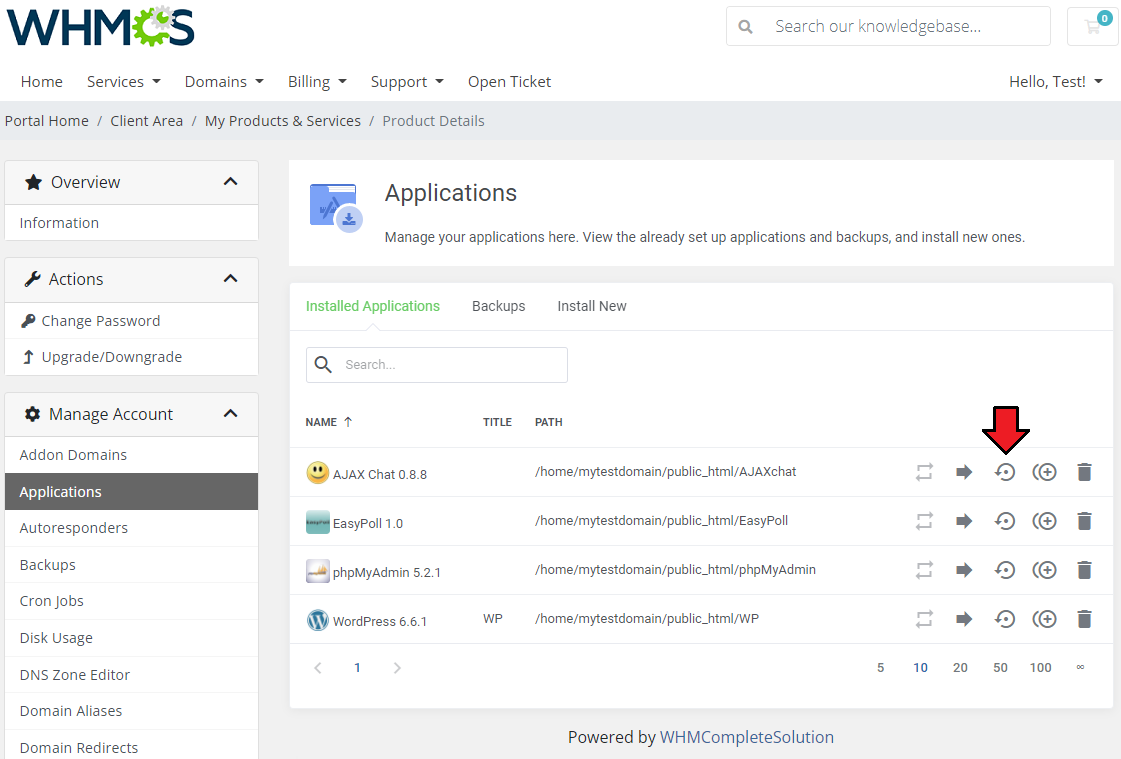
|
| Afterwards, go to 'Backup' tab. Backup creation will be started immediately. |

|
| After a few seconds a progress bar will be fully filled. You should see 'Creating Backup: Completed' message as a confirmation of the operation performed. |
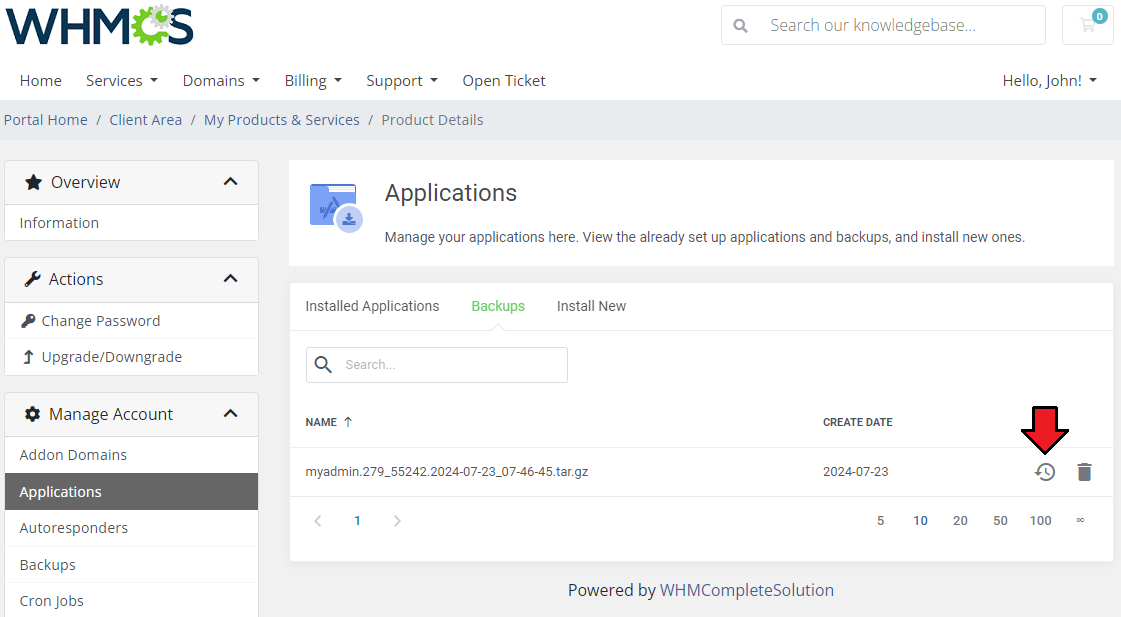
|
| Here you can quickly view, delete or restore existing backups. |
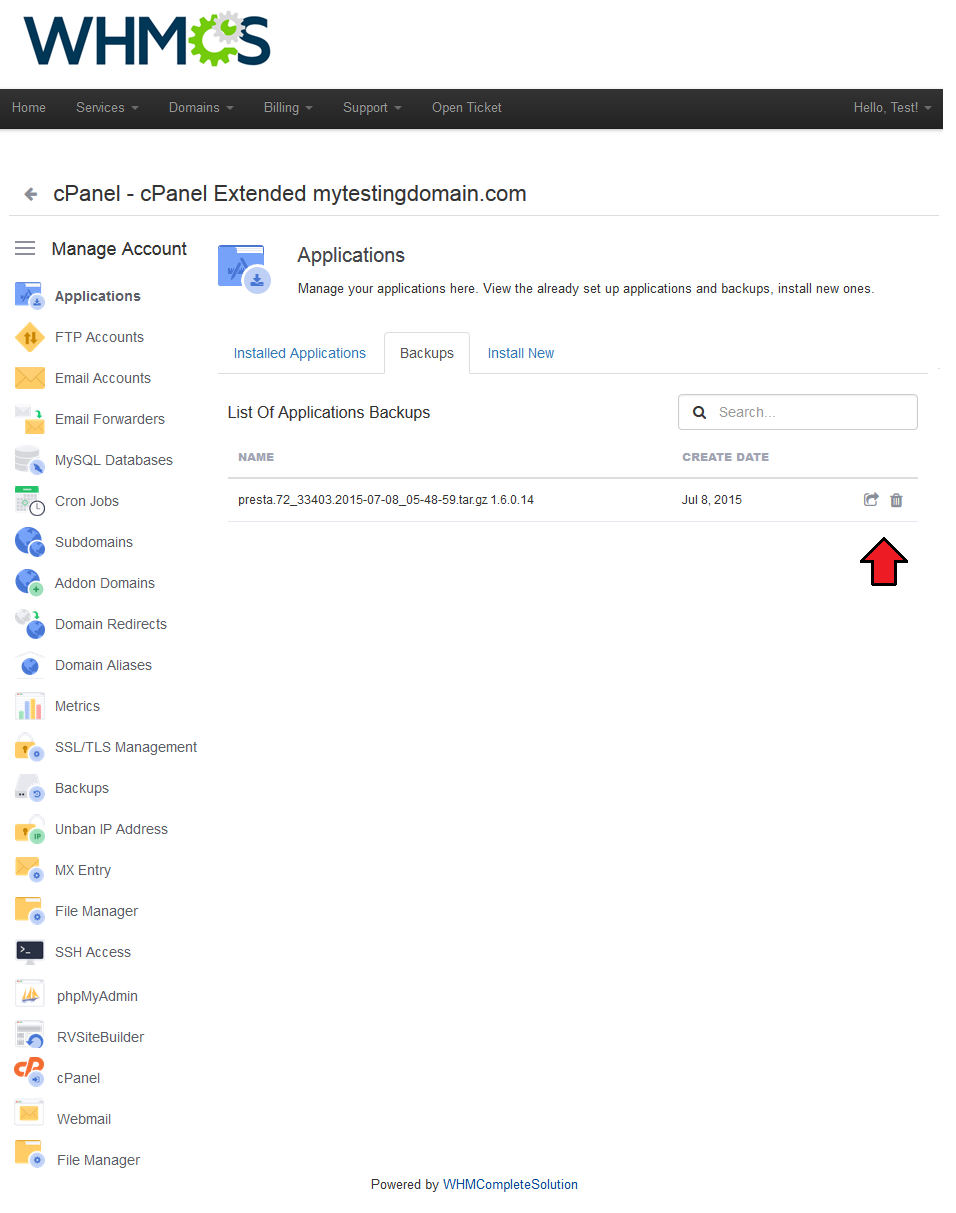
|
Change Password
| Through changing the password you can change both, your cPanel account and FTP account passwords at the same time. |
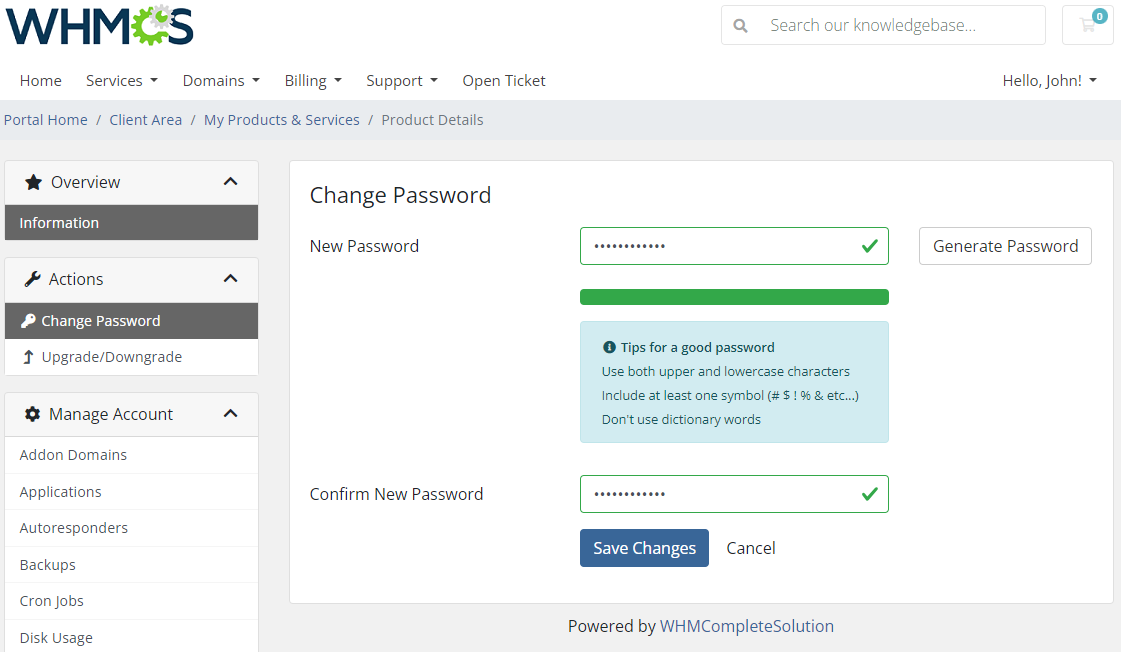
|
Applications Configuration
Configurable Options For Application Autoinstall
| Your customers will definitely love this functionality! With its help you can let them decide which application they would like to install on their new cPanel account. And that's very easy. While placing an order your customer chooses an application and along with account creation this very application will be installed on the account. |
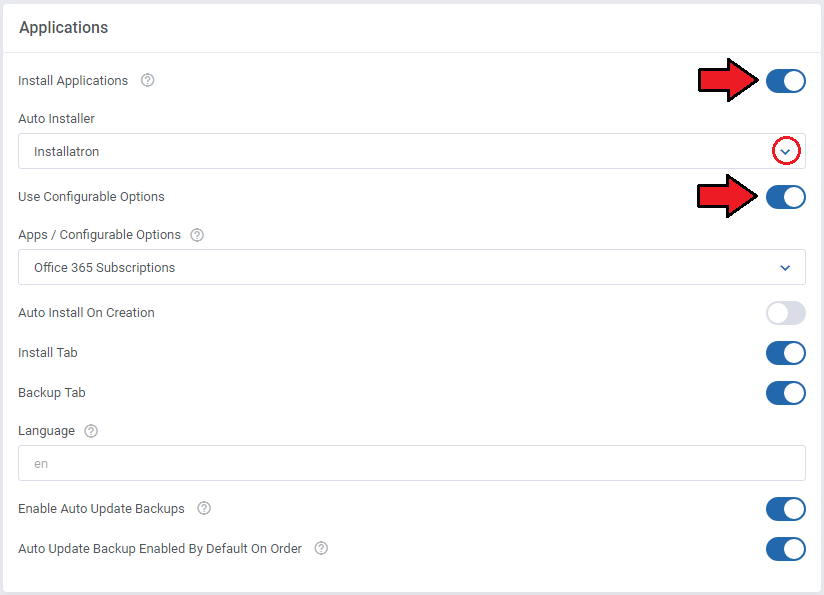
|
| These are the names of values that you can enter in configurable options' fields, we will configure them in the next step. For example, if you would like to set up '4images' in your applications list, you will need to enter value '4images 1.7.11' . |
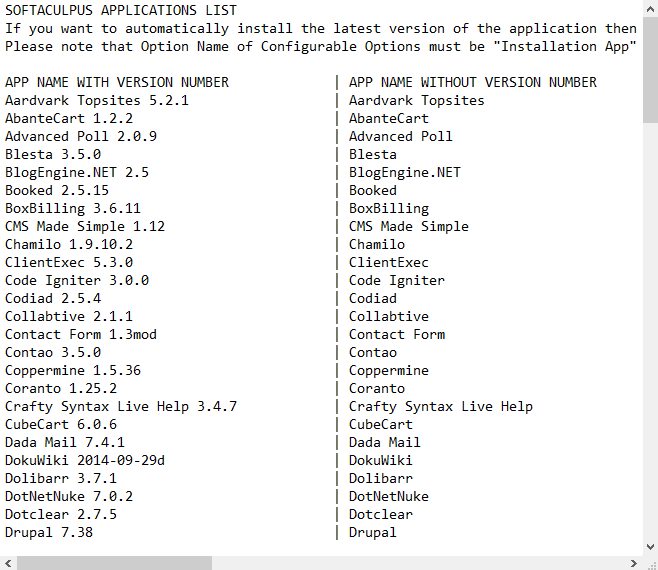
|
| Go to your WHMCS → 'Setup' → 'Products/Services' → 'Configurable Options' and press 'Create a New Group' . |

|
| Enter 'Group Name' of your choice, select product you want to assign configurable options to, then press 'Save Changes' . |
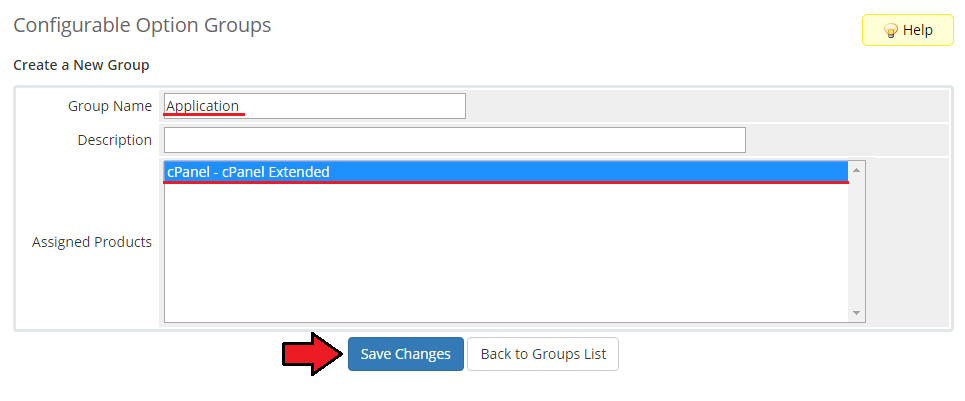
|
| Now click on 'Add New Configurable Option' . |
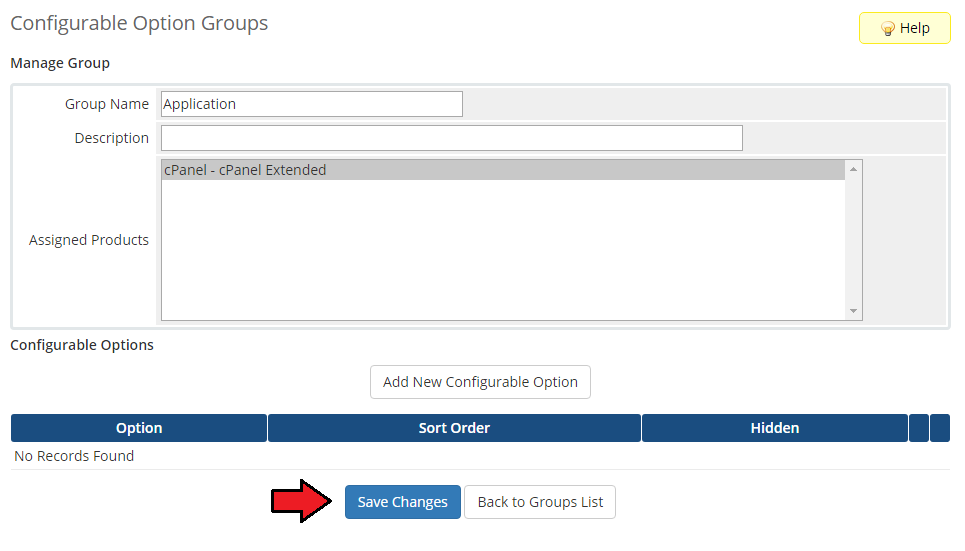
|
| This moment is very important. As 'Option Name' , you have to enter 'Installation App' . In other case the entire functionality will not work. Here you can set up as many applications as you want. To do so, enter a value name e.g. 'Wordpress 3.7.1' and press 'Save Changes' . |

|
| As you can see on the following screen we decided to offer our customers 5 applications. When you finish adding applications, press 'Save Changes' and 'Close Window' . |
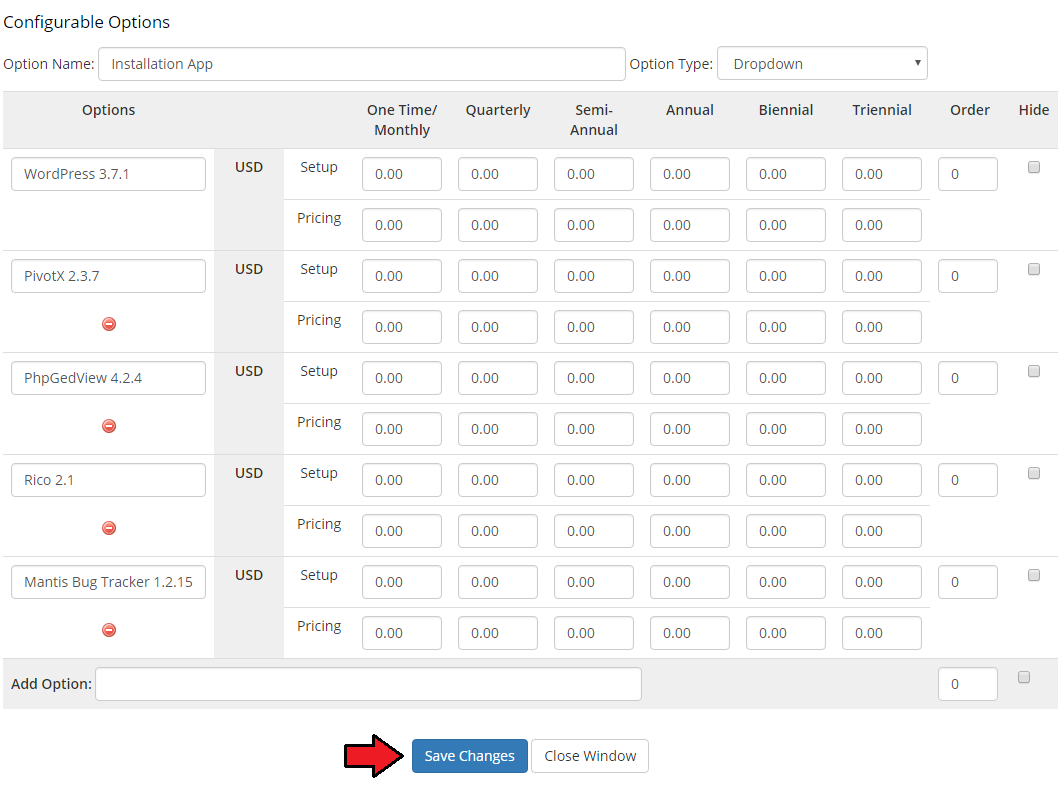
|
| Afterwards, go to 'cPanel Extended Functions' , tick 'Assign To Configurable Options' and choose 'Applications' from a dropdown menu. Please note that you can have more configurable options groups. Press 'Save Changes' and that's it. You have just successfully assigned configurable options to application autoinstall. |
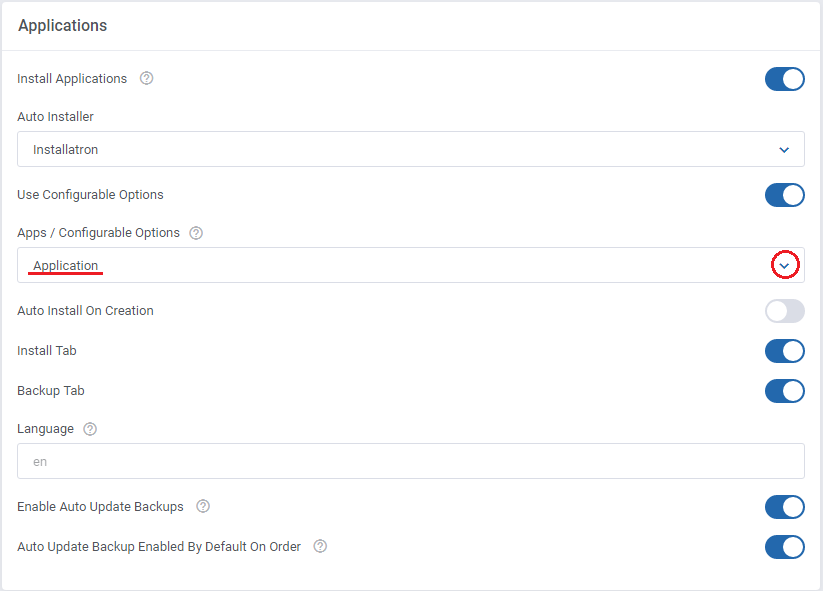
|
| As you can see, a dropdown menu with previously configured applications has shown up. |
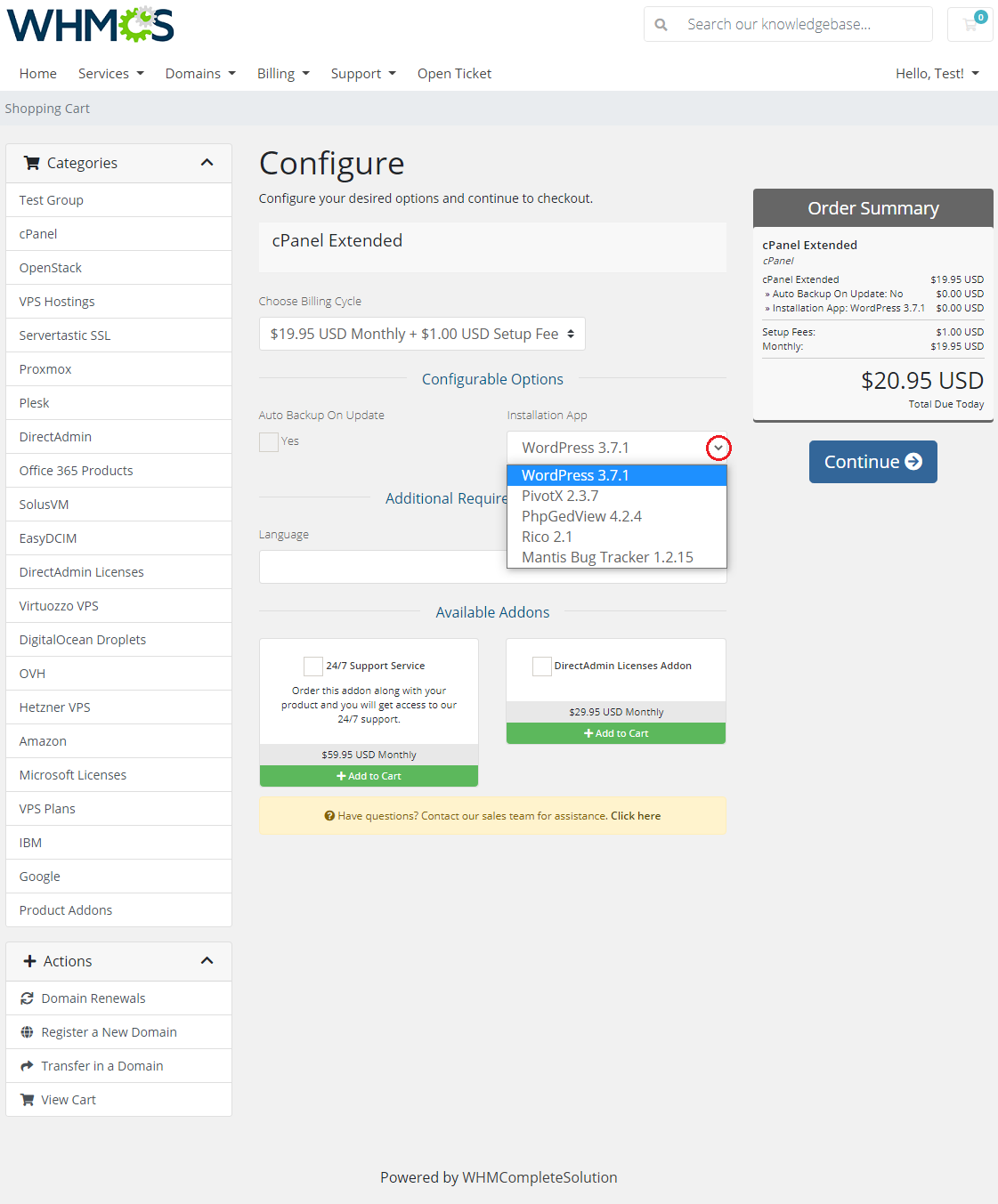
|
Assignment of Custom Fields To Application Autoinstall
| Now, when you know how to allow your customers to choose which application they would like to install on their account, we can proceed one step further. Until that moment applications had been installed with use of default details like e.g. directory names or database name.
Remember to set each field type as 'Text Box' , tick 'Required Field ' and 'Show on Order Form' . |
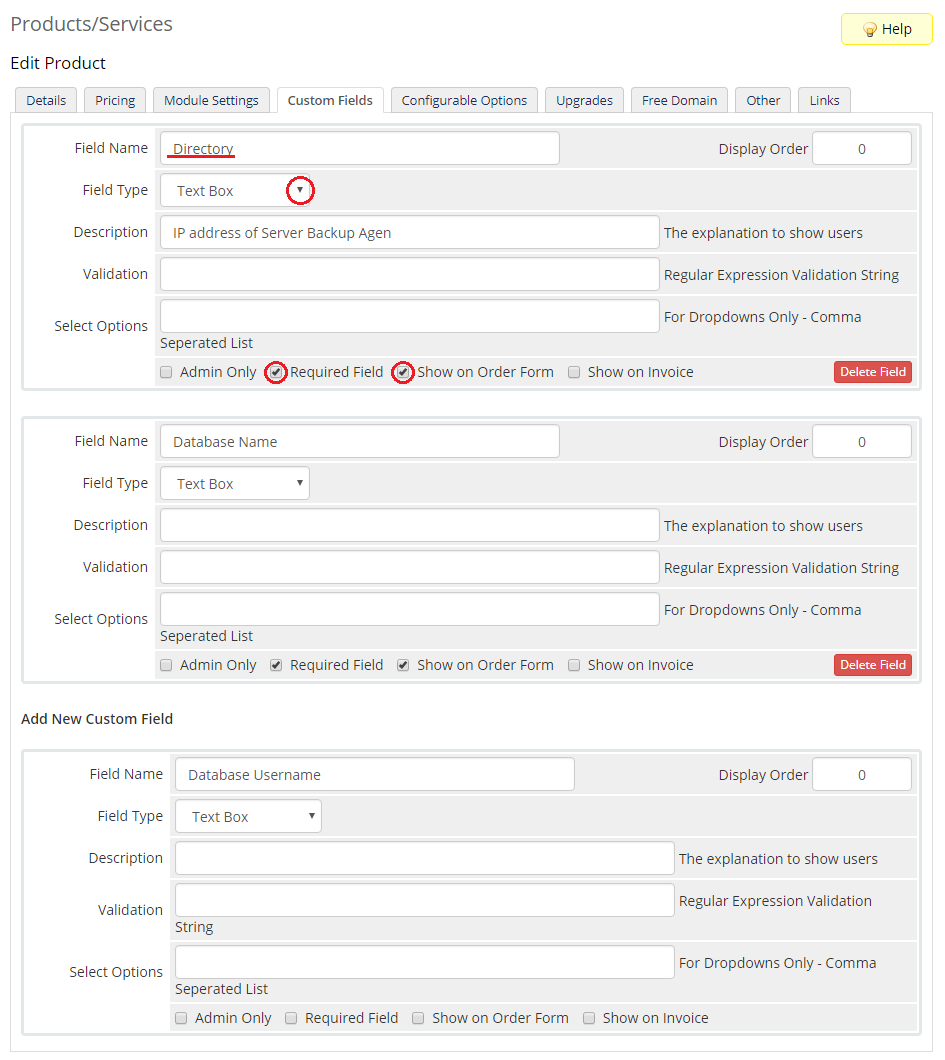
|
The next 3 fields are:
Set them as 'Text Box' and tick 'Show on Order Form' . |
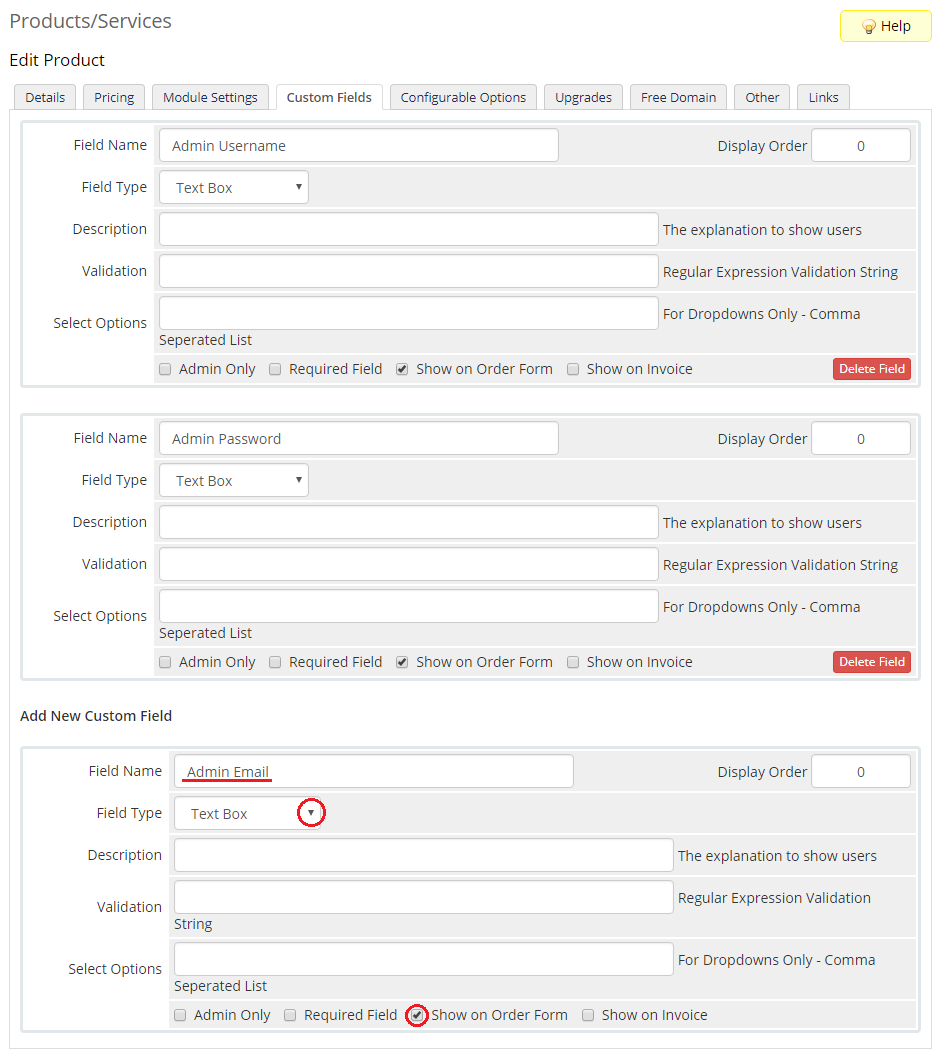
|
The last field is:
Set it as 'Drop Down' , enter 'Yes, No' into 'Select Options' , tick 'Required Field ' and 'Show on Order Form' . |
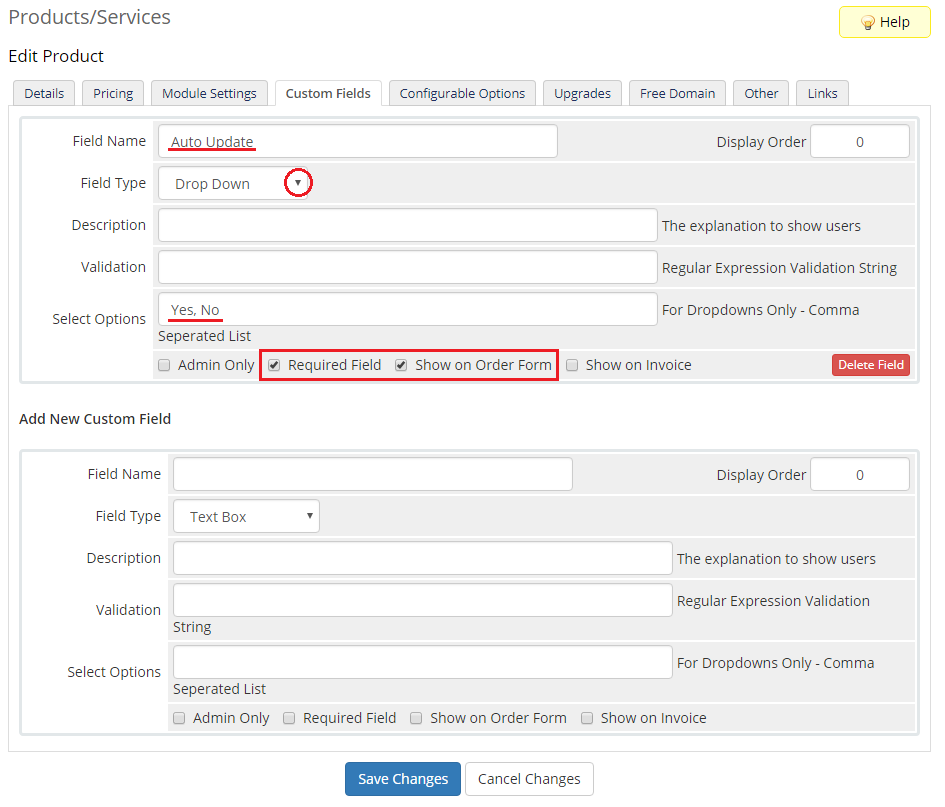
|
| Once you add all the custom fields they will appear while placing an order. Voila! Now your customers can personalize each application without the necessity of installing it later. |
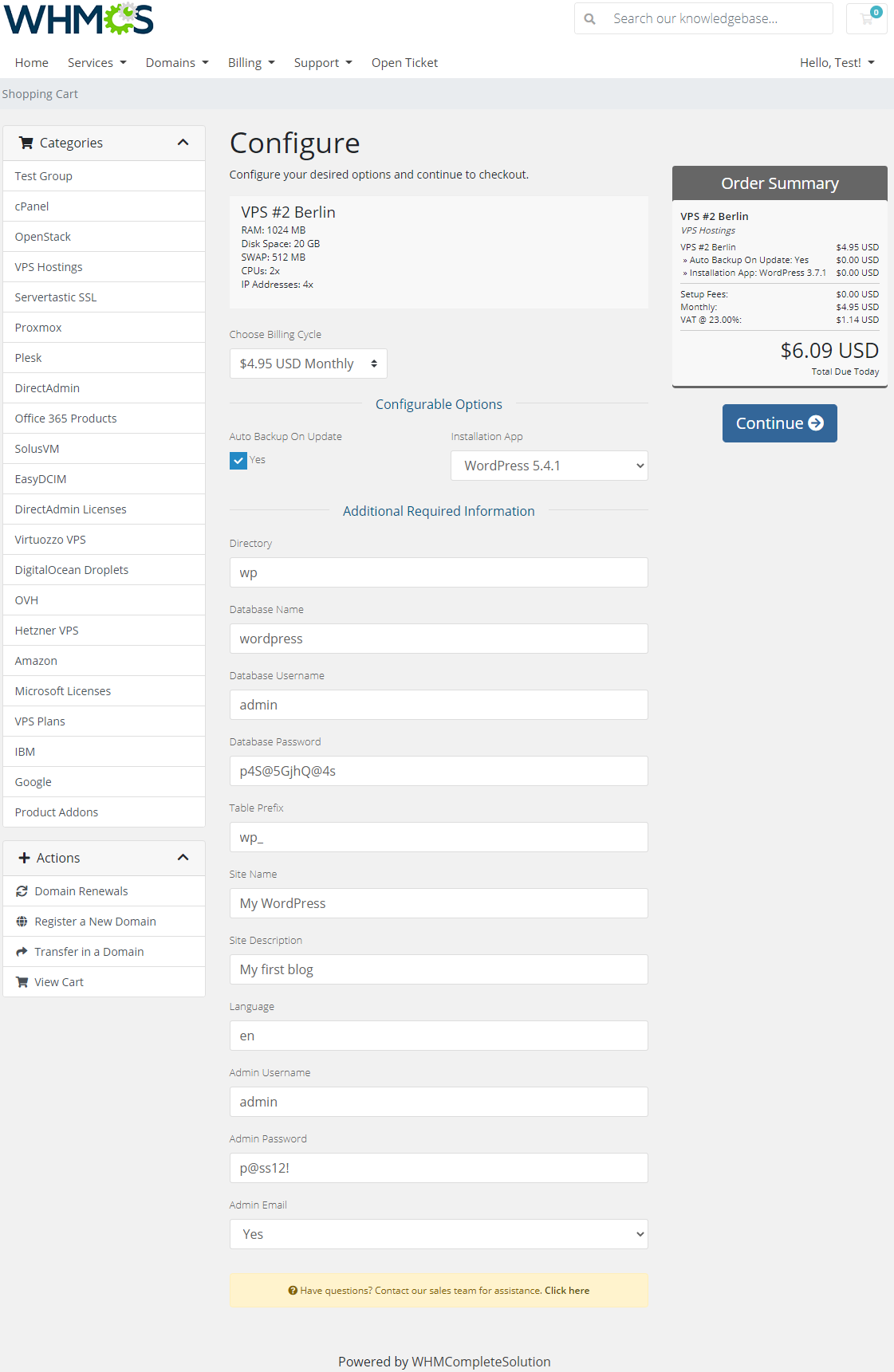
|
Custom Softaculous Application Language
| We will show you how to quickly set custom language for Softaculous web applications. For this purpose you need to add a new custom field for your product. The field should be called 'Language' . |
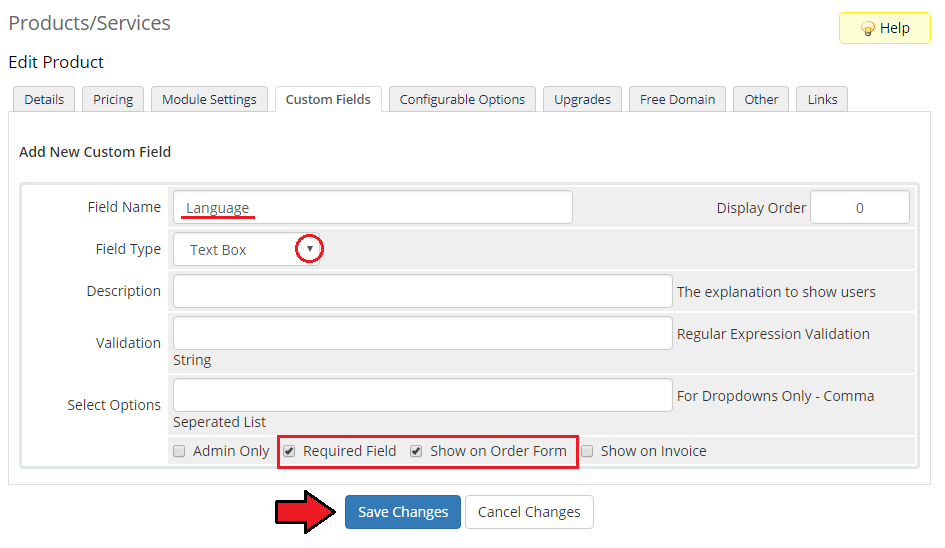
|
| Afterwards go to your 'Products/Services' and check whether 'Language' field has appeared. In order to change default applications language for certain account enter here an appropriate value. |
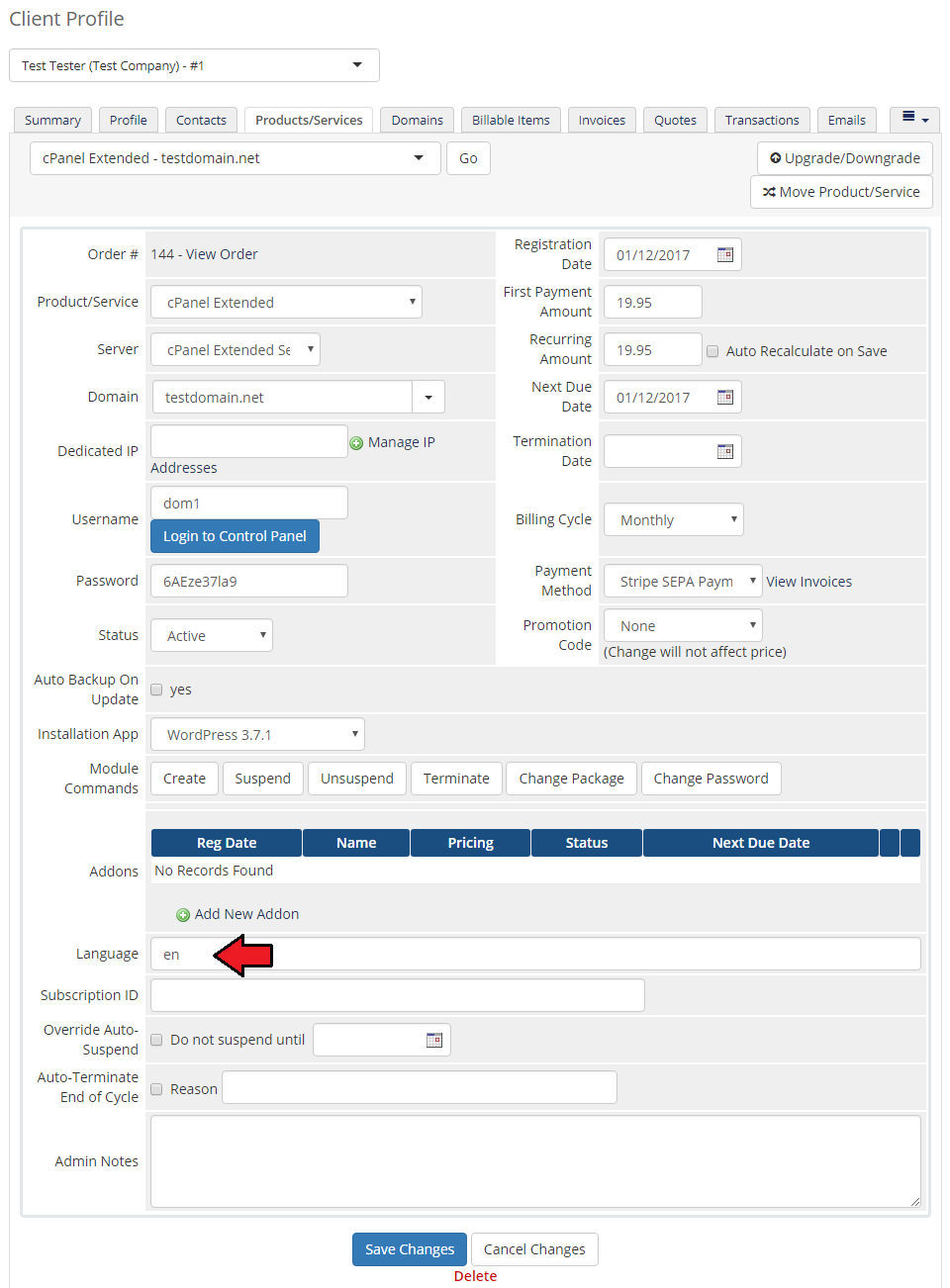
|
| From now on the new field will be visible for your customers as well. While installing a new application they can choose desired language by entering value into the field. Here you will find a complete list of language codes. |
| File:CP65.png |
Management of Existing Products
| You can easily use cPanel Extended module with your already configured cPanel products. To do so, change the type of servers and module names of products from 'Cpanel' to 'CpanelExtended' . |
Management of Billing
| When you combine cPanel Extended For WHMCS with Advanced Billing For WHMCS, you will be able to set up additional billing options. The module allows you to charge your customers basing on the server resources used by them. |
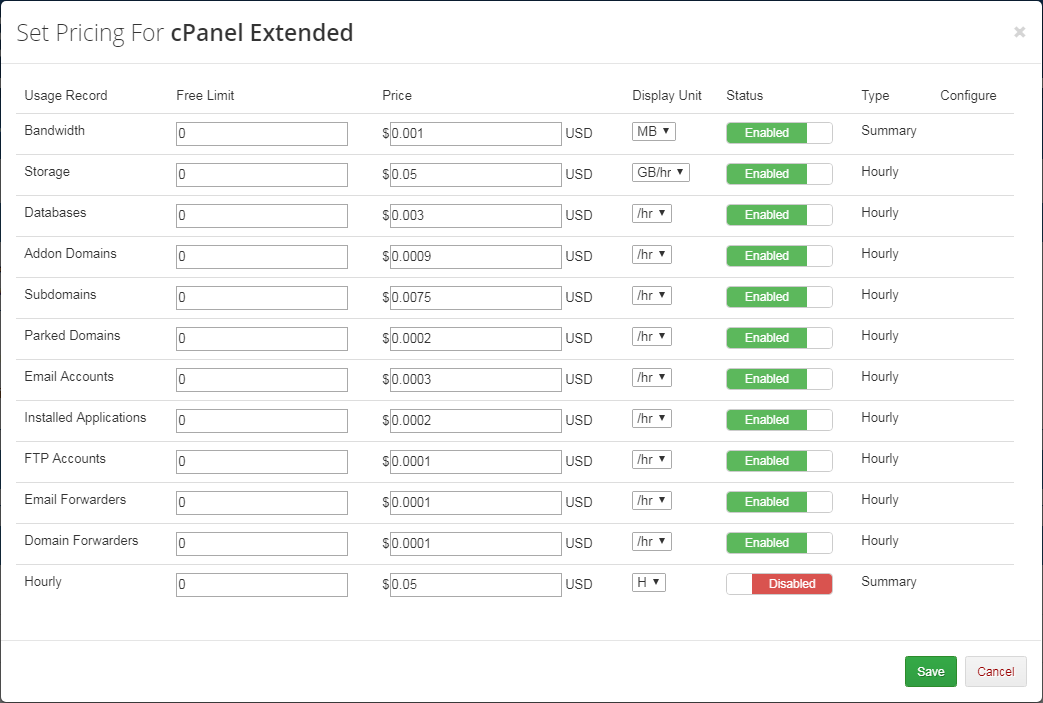
|
| With Advanced Billing module, you can also display the current server resource usage and their cost for your customers. |
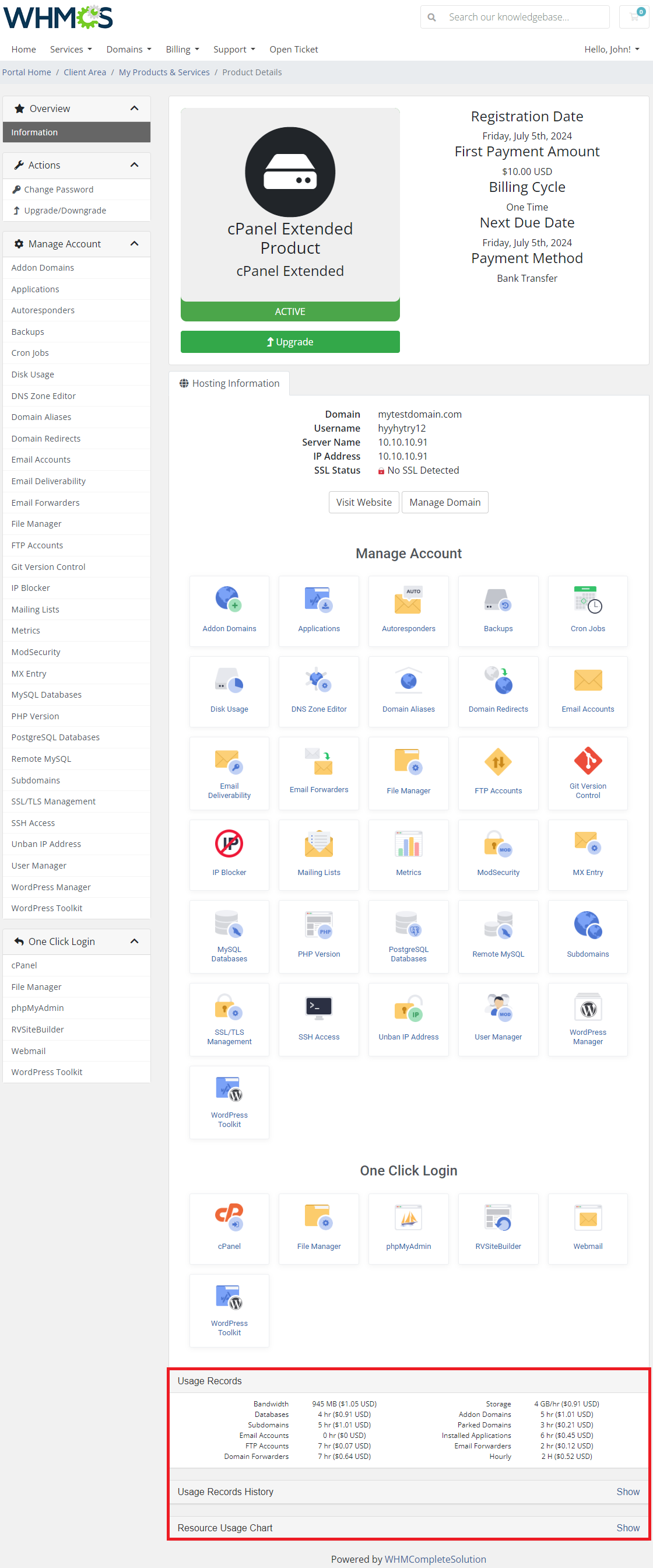
|
How To Update
| 1. Updating cPanel Extended goes alike updating any other MG product, for more information visit Modules Update page. |
Tips
| 1. You can use cPanel Extended with reseller accounts. It gives you new opportunities! To do so, simply go to your cPanel Extended product → 'Details' and choose 'Reseller Account' from a dropdown menu as shown on the following screen. |
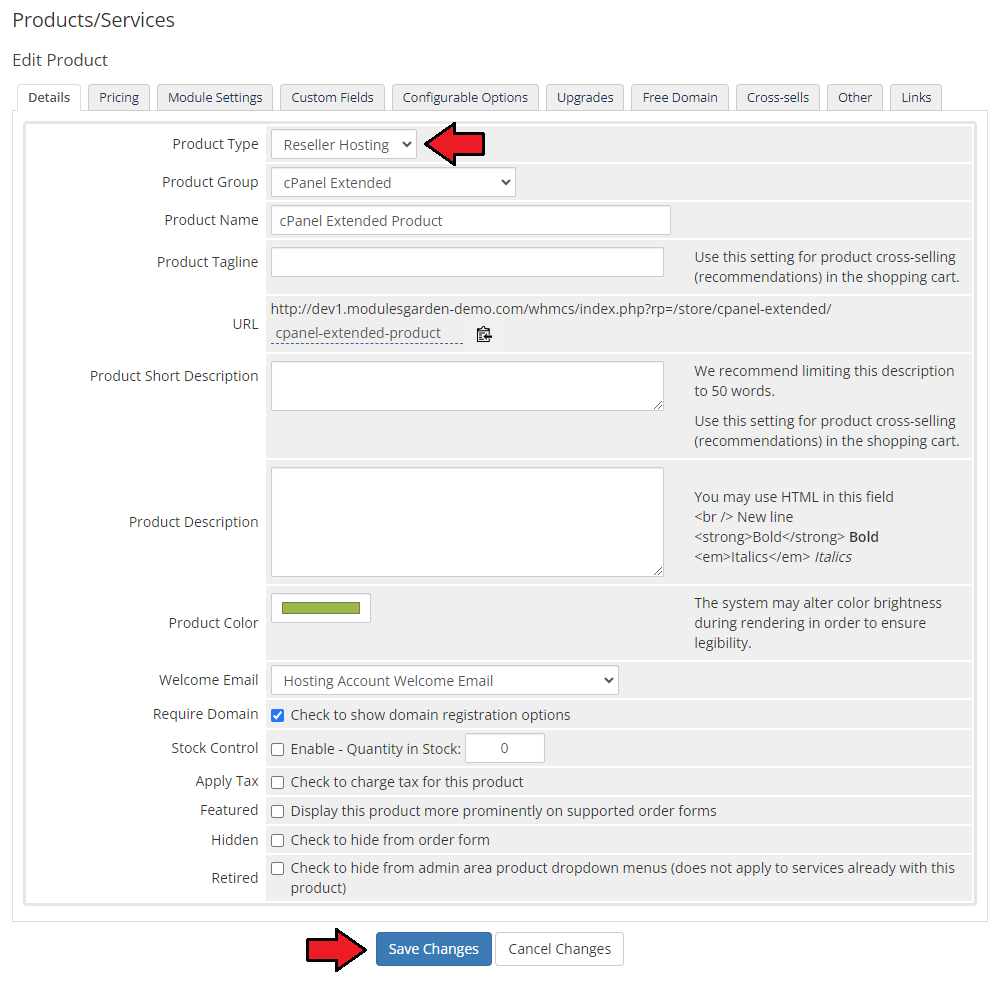
|
| 2. In order to make the reseller account own itself you need to check 'Set the reseller to own their own account' field located in 'Module Settings' . |
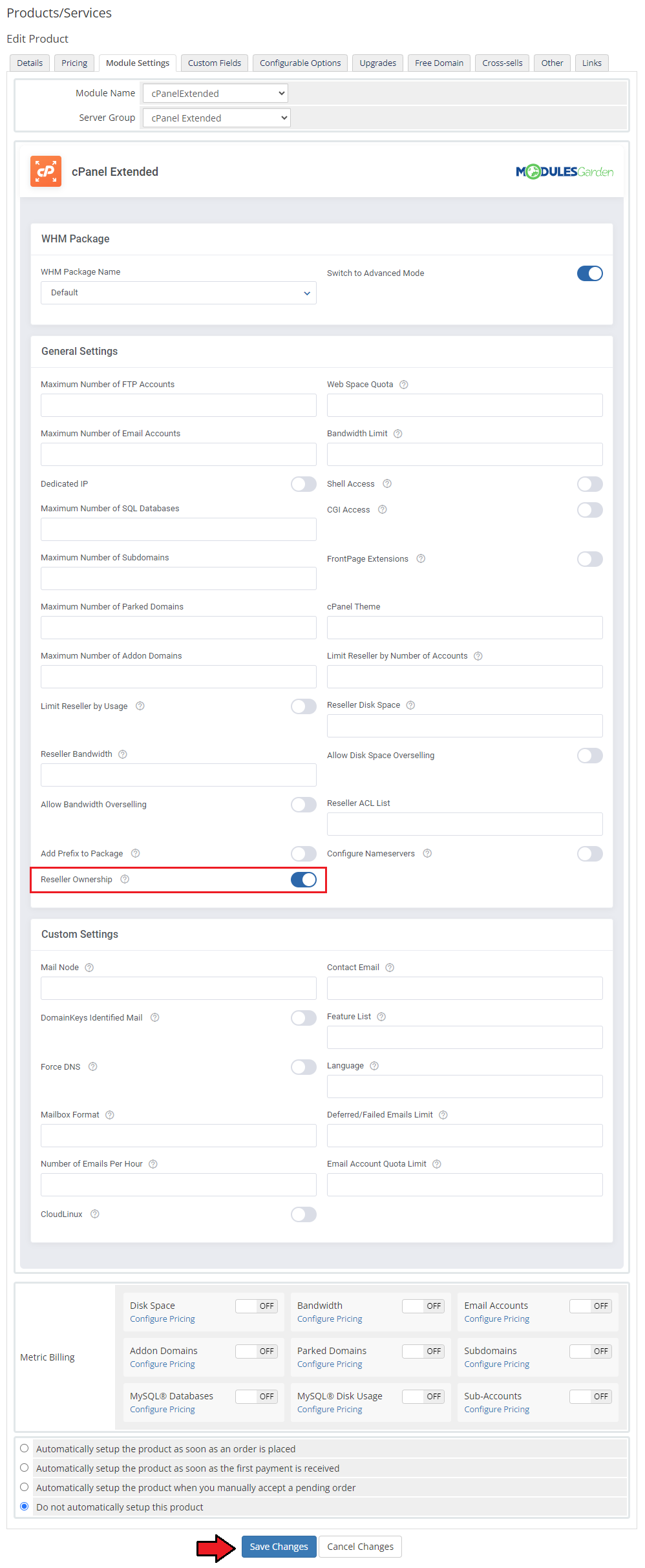
|
| 3. If you would like to use cPanel/WHM Import Utility with cPanel Extended products, you will need to switch products' type to 'Cpanel' . Afterwards you can successfully use the import script. After finishing the import, simply switch back the products' type to 'CpanelExtended' . |
Common Problems
| 1. When you have problems with connection, check whether your SELinux or firewall does not block ports. |
| 2. If after installation, you get an ionCube encoder problem (wrong version), please open a support ticket. We will provide you with different version of the module encrypted with the older version of ionCube. |
| 3. SQL Issue: When you move your WHMCS system to another domain and you import your SQL database you may get an error with missing tables or fields. An example of such an error can be: "Unknown column 's.change_password' in 'field list' ". |
| 4. If you have problems with connection make sure that both ports 2082 and 2083 are open. |
| 5. After you change language of the module, your Ajax notifications might not work correctly. Encode language file in UTF-8 (without BOM) to solve this issue. |
| 6. No results to display: Connection problem: This problem occurs when connection to the cPanel server is not configured properly. |
| Reason: Values inside the field/s 'Hostname' , 'IP Address' , 'Username' , 'Password' , 'Type' and/or 'Access Hash' is/are incorrect. Solution: Verify provided details and test connection through pressing 'WHM' button. |
| 7. No results to display: Wrong hostname or ip value: This problem occurs when connection to the cPanel server is not configured properly. |
| Reason: Values inside the field/s 'Hostname' or 'IP Address' is/are are in the wrong format. Solution: Verify provided details and test connection through pressing 'WHM' button. |
| 8. No results to display: User or domain not found. |
| Reason: Account with the specified domain name doesn't exist on the server. Solution: Make sure that customer's details in your WHMCS system contain specified domain name or create a new account. |
| 9. No results to display: Wrong username value |
| Reason: Account with the specified username doesn't exist on the server. Solution: Make sure that customer's details in your WHMCS system contain specified username or create a new account. |
| 10. No results to display: Access denied |
| Reason: Account already exists on the server but access to the server has been lost due to changed server group, changed server details or block by e.g firewall. Solution: Make sure that connection to your server is working properly and it's not being blocked. Additionally make sure that your server group is set up correctly. |
| 11. User parameter is invalid or was not supplied |
| Reason: Account exists on the server but username is incorrect. Solution: Make sure that customer's account username is the same in both your WHMCS system and your WHM. |
| 12. When you get 'cURL Error : Maximum (20) redirects followed' while trying to install new application, this indicates the problem with your cPanel theme. To solve the problem log in to your WHMCS, go to 'Module Settings' of your product, find the field 'cPanel Theme' and make sure that the entered name is correct. |
| 13. When you have problems with connection, check whether your SELinux or firewall is not blocking ports. |
| 14. Blank page while login into phpMyAdmin or any functionality from 'Stats' page. |
| Reason: Logging in requires SSL connection. Solution: Check 'Secure' in your server settings for cPanel (step 9th of Installation and Configuration). |
| 15. Running 'Create' on cPanel Extended product does not create application ordered along with product. Reason: Some applications require additional fields during installation (other than those available in the product custom fields). |